Windows 11 bekommt neu gestaltete 2D-Emojis

Das Windows-11-Update KB5007262 bringt neue 2D-Emojis statt des ursprünglich versprochenen 3D-Stils. Hier erfahren Sie, wie Sie sie erhalten.

AKTUALISIERT AM 05.01.2022: Windows 11 (Version 21H2) wurde am 5. Oktober 2021 veröffentlicht und stellt die nächste Generation von Windows dar, die neue Funktionen und Verbesserungen einführt, um die Sicherheit und Produktivität zu verbessern und das gesamte Erlebnis zu modernisieren.
In dieser Version finden Sie bedeutende Änderungen an der Benutzeroberfläche für das Startmenü, die Taskleiste, die Einstellungen und den Datei-Explorer, darunter abgerundete Ecken, aktualisierte Schriftarten und ein einheitliches Design für alle Komponenten.
Obwohl dies eine neue Version ist, basiert sie immer noch auf der Windows 10-Technologie, was bedeutet, dass sie die gleiche Kompatibilität für Anwendungen und Treiber beibehält. Dieses Mal erhöht Windows 11 jedoch die Systemanforderungen und lässt viele Geräte ohne die Möglichkeit eines Upgrades.
Am 5. Oktober begann Microsoft damit, Windows 11 als kostenloses Upgrade für neue Geräte anzubieten, auf denen bereits Windows 10 ausgeführt wird und von denen bekannt ist, dass sie ein reibungsloses Upgrade-Erlebnis bieten. Im Laufe der Zeit wird das Betriebssystem basierend auf Hardwareeignung, Zuverlässigkeitsmetriken, Alter der Hardware und anderen Faktoren auf mehr Computer ausgeweitet. Irgendwann in der zweiten Hälfte des Jahres 2022 wird Windows 11 dann für kompatible Geräte vollständig verfügbar sein.
Wie bei früheren Versionen erhalten Sie eine Benachrichtigung, die neue Version manuell über Windows Update herunterzuladen. Wenn Sie ein „Sucher“ sind, können Sie das Upgrade erzwingen, indem Sie in den Windows Update-Einstellungen auf die Schaltfläche Nach Updates suchen und dann auf die Schaltfläche Herunterladen und installieren klicken . Alternativ können Sie das neue Update auch mit dem Media Creation Tool installieren , um ein Inplace-Upgrade oder eine Neuinstallation durchzuführen . Darüber hinaus können Sie den Installationsassistenten verwenden oder sogar die ISO-Datei herunterladen, um ein bootfähiges USB-Medium zu erstellen , das Sie für die Aktualisierung verwenden können.
Was ist neu bei Windows 11
Hier sind alle neuen Windows 11-Funktionen verfügbar, vom neu gestalteten Startmenü über die zentrierte Taskleiste bis hin zum Action Center-Erlebnis, den neuen Widgets, Desktops, dem Datei-Explorer, der überarbeiteten Einstellungs-App, Verbesserungen unter der Haube und mehr.
Neues Windows 11-Startmenü
Windows 11 verfügt über ein neu gestaltetes Startmenü, das die Live-Kacheln zugunsten traditioneller Symbole und eines neuen minimalistischen Designs aufgibt. Das Menü basiert auf dem Design des Unternehmens für Windows 10X. Es schwebt über der Taskleiste und folgt dem neuen Design im OS-Stil mit abgerundeten Ecken und halbtransparenten Materialien.
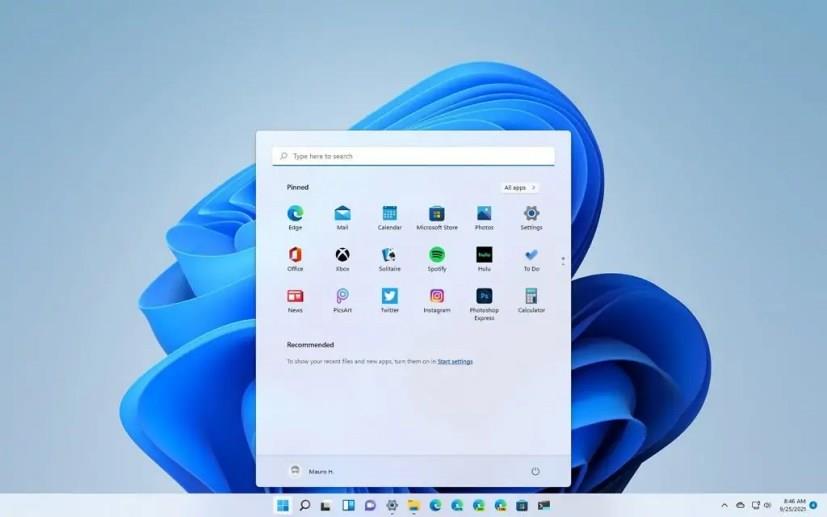
Windows 11 Startmenü
Das Menü ist in vier Abschnitte unterteilt. Oben befindet sich ein Suchfeld, das beim Klicken auf die Windows-Suche umschaltet, die der von Windows 10 ähnelt , jedoch mit geringfügigen Änderungen.
Der angeheftete Abschnitt enthält alle Ihre Lieblings-Apps und enthält mehrere Seiten, wenn Sie weitere Apps hinzufügen. In der oberen rechten Ecke finden Sie eine Schaltfläche, um auf die Liste „Alle Apps“ zuzugreifen, die wie die Liste unter Windows 10 funktioniert.
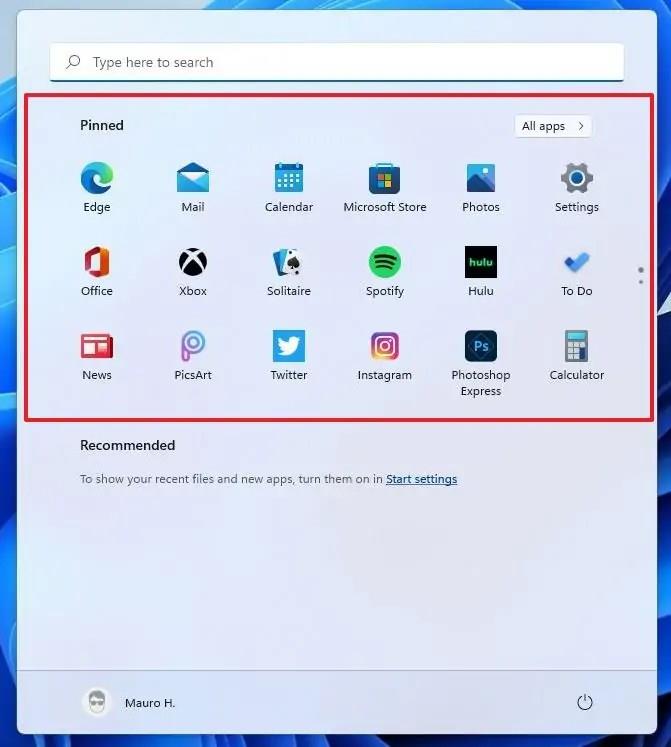
Startmenü angeheftet
Das Startmenü enthält jetzt einen empfohlenen Abschnitt, der wie eine „Zeitleiste“ funktioniert und die am häufigsten verwendeten Elemente, einschließlich Dokumente und Ordnerspeicherorte, anzeigt.
Schließlich finden Sie unten das Profilmenü, das die Optionen zum Ändern der Kontoeinstellungen, Sperren, Abmelden und Benutzerwechsel enthält. Auf der rechten Seite befindet sich das Power-Menü, aber die Optionen sind je nach den Fähigkeiten des Geräts unterschiedlich. Auf dem verbleibenden Platz können Sie schnell auf Ordner zugreifen, einschließlich Dokumente, Downloads, Einstellungen usw.
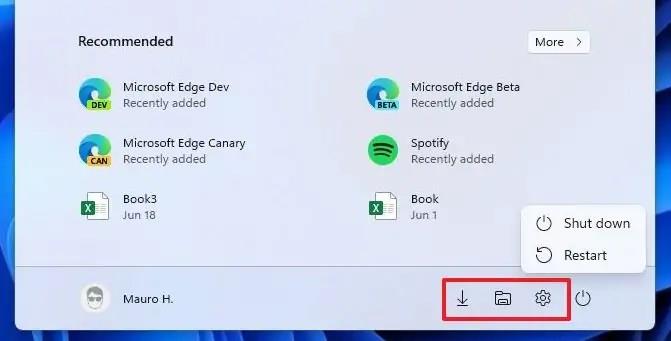
Ordnerelemente
Ab Windows 11 wird das Startmenü in der Mitte des Bildschirms ausgerichtet, aber Sie können es mit der App „Einstellungen “ links ausrichten .

Taskleiste zentriert und links ausgerichtet
Sie können auch weiterhin verschiedene Aspekte der Erfahrung im Menü anpassen, um das Auffinden und Starten von Apps zu vereinfachen. Sie können beispielsweise immer noch mit der rechten Maustaste auf die App klicken, um sie im Abschnitt „Pinned“ verfügbar zu machen.

Kontextmenü starten
Sie können die Elemente per Drag & Drop an die gewünschte Position ziehen, sogar auf eine andere Seite. Oder Sie können mit der rechten Maustaste auf das Element klicken und die Option „Nach oben verschieben“ auswählen. Außerdem ist es möglich, die App über das Kontextmenü von der Start- oder Taskleiste zu lösen.
Wenn Sie die App entfernen müssen, enthält das Kontextmenü eine Option zum Deinstallieren mit einem neuen Dialogdesign.
Da es im Abschnitt „Pinned“ mehrere Seiten gibt, können Sie mit dem Mausrad scrollen oder die Punkte auf der rechten Seite verwenden.
Der empfohlene Abschnitt zeigt die zuletzt installierte App, häufig verwendete Apps und kürzlich geöffnete Dateien. Sie können entscheiden, was in diesem Abschnitt des Menüs auf der Seite Starteinstellungen angezeigt wird. Oder Sie können jederzeit mit der rechten Maustaste auf ein Element klicken und die Option auswählen, um es aus der Liste zu entfernen. Wenn das System weitere Empfehlungen hat, sehen Sie die Schaltfläche Mehr , um eine Liste mit allen Dateien und Apps anzuzeigen, die Sie kürzlich verwendet haben.
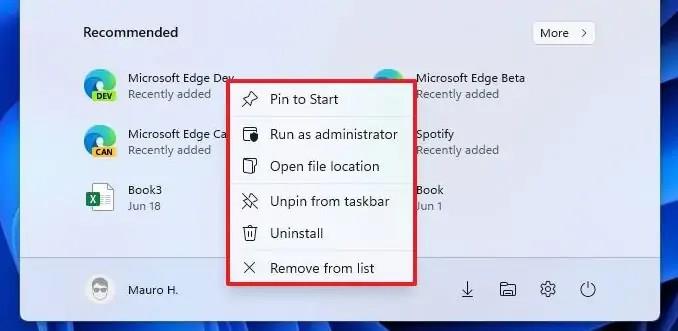
Empfohlenes Element entfernen
Obwohl Sie Elemente in diesem Abschnitt entfernen können , wird der Bereich leer angezeigt, wenn Sie versuchen, alle Elemente zu löschen, anstatt den Abschnitt „Angeheftet“ zu erweitern, um mehr Ihrer angehefteten Apps anzuzeigen.
Wenn ein Element an „Start“ angeheftet, aber nicht installiert ist, wird ähnlich wie im klassischen Menü beim Klicken darauf eine Ladeleiste angezeigt, bis die App aus dem Microsoft Store installiert ist.
Während der neue Start viele gute Dinge hat, fehlen dem Menü viele Funktionen und Flexibilitäten der klassischen Erfahrung. Eine der wichtigsten Änderungen des neuen Designs ist beispielsweise, dass Live-Kacheln nicht mehr verfügbar sind. Infolgedessen entfällt auch die Option zum Ändern der Größe.
Sie haben nicht mehr die Möglichkeit, das Startmenü im Vollbildmodus zu verwenden. Sie können die Größe des Menüs nicht mit der Maus ändern, und es gibt auch keine Option zum Ändern der Größe in der App "Einstellungen". Die Möglichkeit, Apps in Ordnern zu gruppieren, ist weg, und standardmäßig werden mehrere werbeähnliche Apps mitgeliefert, die schwer von installierten Apps zu unterscheiden sind.
Außerdem wurde in der Liste „Alle Apps“ der Ordner „Windows-Verwaltung“ durch die Option „Windows-Tools“ ersetzt, die die Seite „Windows-Tools“ in der Systemsteuerung öffnet. Die Seite kombiniert alle Optionen, die in den Ordnern „Windows-Verwaltung“, „Windows-Zubehör“, „Windows PowerShell“ und „Windows-System“ verfügbar sind.
Neue Taskleiste
Obwohl es ähnlich aussehen mag, ist die Taskleiste neu. Das erste, was Sie bemerken werden, ist, dass die Taskleiste jetzt in der Mitte des Bildschirms ausgerichtet ist. Die neu gestaltete Erfahrung umfasst auch eine neue Startschaltfläche und neue Schaltflächen für den Zugriff auf verschiedene Funktionen, darunter Suche, Aufgabenansicht, Widgets und Chat.

Schaltflächen der Windows 11-Taskleiste
Sie können die Schaltflächen in der Taskleiste nicht entfernen, aber Sie können sie auf der Seite mit den Taskleisteneinstellungen ausblenden.
Neben dem neuen Design verfügt die Taskleiste über neue Animationen für viele Aktionen, unter anderem beim Installieren, Maximieren, Minimieren und Starten einer App. Und es gibt eine neue Bounce-Animation für Apps, wenn das Konto beim Start geladen wird. Unter der App-Schaltfläche sehen Sie jetzt einen pillenförmigen Indikator, der die Größe für laufende Apps ändert, um anzuzeigen, wo sie minimiert oder maximiert sind.
Unter Windows 11 hat die Taskleiste hervorragende und nicht so gute Änderungen. Beispielsweise ist das Erlebnis jetzt standardmäßig in der Mitte ausgerichtet, aber es ist möglich, die Ausrichtung nach links zu ändern, indem Sie die Einstellungen ändern.
Die Benutzeroberfläche ist etwas größer als zuvor, und Elemente wie Tooltips, Vorschauen, Überlaufmenü und das Überfahren von Schaltflächen folgen jetzt dem neuen Designstil mit abgerundeten Ecken und Materialien.
Wenn eine Anwendung Aufmerksamkeit erfordert, wird das Blinken subtiler, es hört auf, und es gibt eine neue Rückplatte mit einer hellroten Farbe und einem roten Pillensymbol, das darüber informiert, dass die App Aufmerksamkeit erfordert.
Snap-Gruppen
Windows 11 enthält auch neue Multitasking-Verbesserungen, einschließlich „Snap-Gruppen“, einer Funktion, mit der Sie eine App, die zu einer Reihe von Fenstern gehört, die auf dem Bildschirm eingerastet sind, mit der Maus bewegen können, um zu einer eingerasteten Gruppe zu wechseln, ohne schnell etwas neu einrasten zu müssen. Diese Funktion ist praktisch, wenn Sie mit mehreren Fenstern arbeiten und dann plötzlich zu einer anderen App wechseln und dann zurück zur Gruppe der eingerasteten Fenster wechseln möchten.

Snap-Gruppen
Außerdem enthält die Taskleiste kein Suchfeld mehr. Stattdessen finden Sie eine Suchschaltfläche zum Öffnen der Windows-Suchfunktion, die dieselbe bleibt wie die unter Windows 10 verfügbare.
Neu gestaltete Taskleiste
Die Taskleiste hat auch eine neu gestaltete Taskleiste, die verwandte Symbole in einer einzigen Schaltfläche gruppiert, um das neue „Benachrichtigungszentrum“ und „Schnelleinstellungen“ zu öffnen. Wenn Sie beispielsweise auf die Gruppe klicken, die die Symbole für Netzwerk, Lautstärke und Akku enthält, wird das Flyout für die Schnelleinstellungen geöffnet.
Wenn Sie auf die Symbole für Uhrzeit und Datum und Benachrichtigungen klicken, wird das Flyout des Benachrichtigungscenters geöffnet.

System Tray
Sie können auch mit der rechten Maustaste auf jedes Element klicken, um sein Kontextmenü zu öffnen und auf die verschiedenen verfügbaren Optionen zuzugreifen.
Das Hauptkontextmenü der Taskleiste wurde aus Windows 11 entfernt und durch eine einzige Option ersetzt, um die Seite mit den Taskleisteneinstellungen zu öffnen, auf der Sie verschiedene Aspekte der Erfahrung konfigurieren können.

Kontextmenü der Taskleiste
Sie können Schaltflächen auf der Einstellungsseite ein- oder ausblenden, die Symbole steuern, die in der Taskleiste und im Eckenüberlauf angezeigt werden, die Ausrichtung der Taskleiste ändern und das automatische Ausblenden für die Taskleiste aktivieren oder deaktivieren. Und es gibt sogar eine Option zum Ausblenden der Schaltfläche zum Anzeigen des Desktops.
Designprobleme
Beim Versuch, die Erfahrung zu vereinfachen, scheint Microsoft die Taskleiste weniger flexibel zu machen. Beispielsweise ist die Benutzeroberfläche jetzt unten gesperrt und Sie können sie nicht auf die obere, linke oder rechte Seite des Bildschirms verschieben. (Wenn Sie die Taskleiste verschieben möchten, müssen Sie eine Problemumgehung verwenden .)
Sie können keine Apps oder Dateien mehr ablegen, um die Elemente an die Taskleiste anzuheften.
Die Möglichkeit, Beschriftungen für Anwendungen anzuzeigen, ist weg, und Sie haben jetzt nur noch die Symbolansicht.
Es ist nicht mehr möglich, die Größe der Symbole zu ändern, ebenso wenig wie die Höhe der Taskleiste.
Die Option zum Ausblenden von Datum und Uhrzeit ist weg, und beim Öffnen des Benachrichtigungszentrums wird die Zeit nicht mehr mit Sekunden angezeigt. Außerdem wird die Zeit nur in der primären Anzeige angezeigt.
Schließlich können Sie Systemsymbole wie Netzwerk, Lautstärke, Energie usw. nicht mehr aus der Taskleiste ausblenden.
Neues Benachrichtigungszentrum und Schnelleinstellungen
Action Center ist unter Windows 11 keine Sache mehr. Stattdessen haben Sie jetzt zwei neue Erfahrungen, darunter „Notification Center“ und „Quick Settings“.
Nachrichtencenter
Durch Klicken auf die Gruppe von Symbolen mit Uhrzeit und Datum und Benachrichtigungen oder durch Verwenden der Tastenkombination Windows-Taste + N wird die Benachrichtigungszentrale geöffnet .
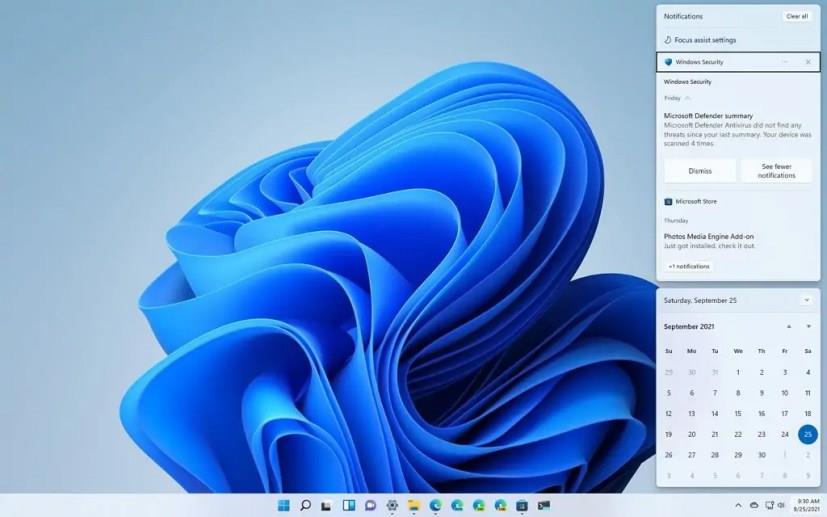
Nachrichtencenter
Die Benutzeroberfläche verfügt über zwei gestapelte Gruppen, die das neue Stildesign mit abgerundeten Ecken und halbtransparenten Materialien verwenden.
Ganz oben finden Sie alle Ihre Benachrichtigungen. Die Benutzeroberfläche sieht möglicherweise anders aus, funktioniert jedoch genauso wie unter Windows 10. Wenn Sie mehr als eine Benachrichtigung von derselben App haben, zeigt das System nur die neueste an, blendet das Zurücksetzen aus und teilt Ihnen die Nummer mit von Nachrichten, die Sie nicht gesehen haben.
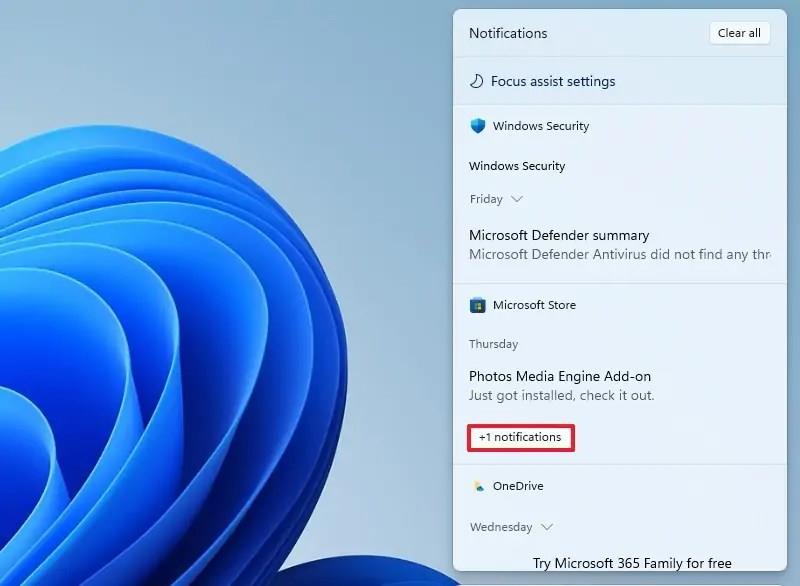
Benachrichtigungsliste
Unten finden Sie den Kalender mit dem aktuellen Datum oben, aber ohne Uhrzeit. Im Gegensatz zum Kalender in früheren Versionen zeigt dieser keine bevorstehenden Ereignisse an, noch können Sie neue Ereignisse direkt über diese Benutzeroberfläche erstellen.
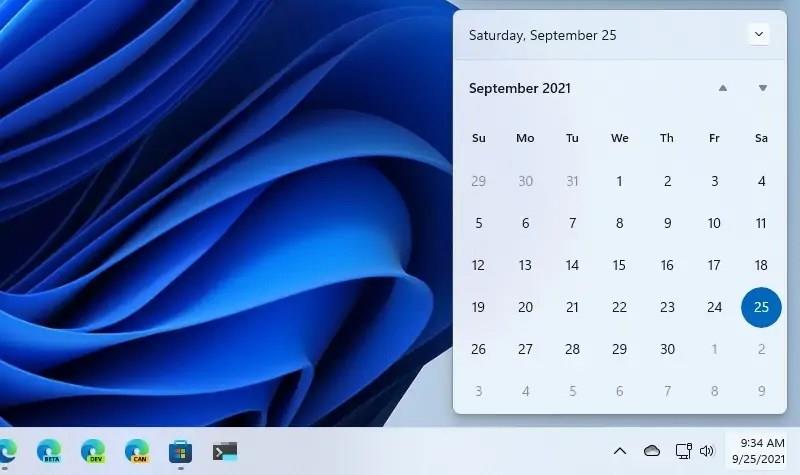
Kalender-Flyout
If you need to access the notification settings, you can always right-click the notification icon and choose the Notifications settings option. Or you can click the Focus assist settings option at the top.
Quick Settings
On Windows 11, you can open Quick Settings by clicking the network, volume, and power group of icons or using the Windows key + A keyboard shortcut.
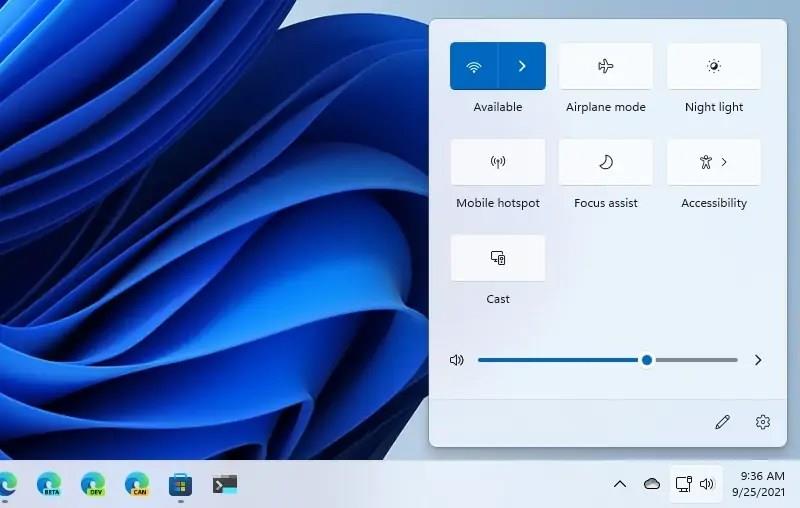
Quick Settings
The flyout lets you control quick settings like Wi-Fi, Bluetooth, Airplane mode, Battery saver, Focus Assist, Accessibility, Night light, Cast, Keyboard layout, Mobile hotspot, Nearby sharing, and Project. Also, depending on the feature, you can open a submenu with the option to control the experience further. For instance, clicking the button next to Accessibility will allow you to enable or disable the Magnifier, Color filters, Narrator, Mono audio, and Sticky keys.
If the feature is available, you can also control brightness and adjust the system volume.
In the interface, you will also find the battery level, option to edit the items you want to see in the layout, and quick access to the Settings app.
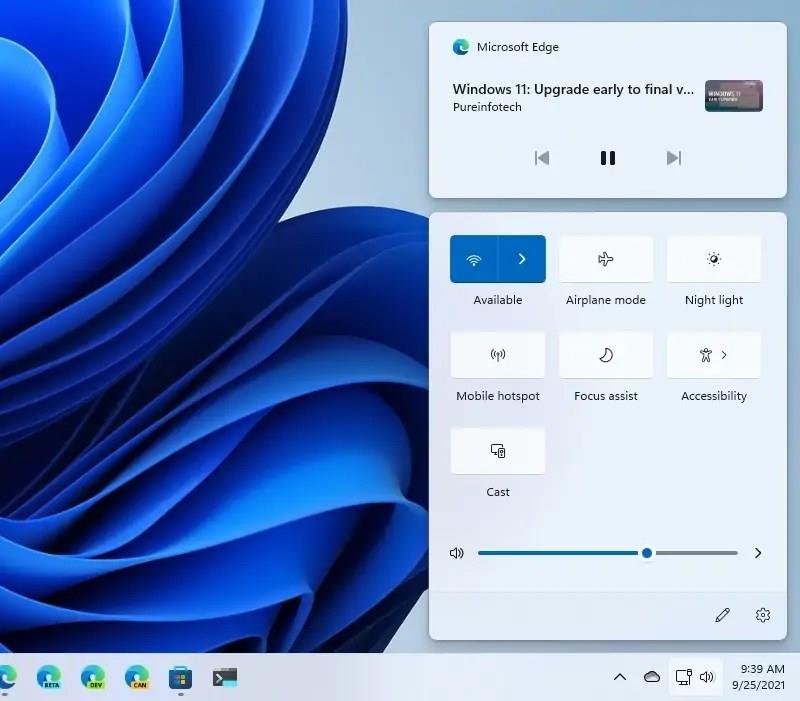
Quick Settings media controls
On Windows 11, above the Quick Settings flyouts, you will also find media controls when playing videos in Google Chrome, Microsoft Edge, or supported media apps.
Windows 11 Widgets feature
Windows 11 includes a feature called “Widgets,” a new interface that slides in from the left side of the screen to provide different types of information, such as weather, news, tracking, sports, entertainment, and more.
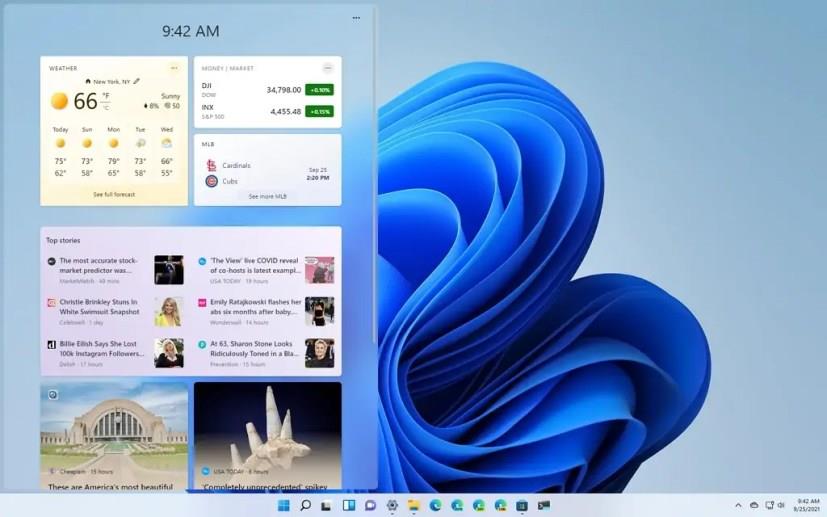
Windows 11 Widgets
If this experience looks familiar, it’s because this is the evolution of “news & interests” available on Windows 10.
You can open Widgets with the dedicated button in the Taskbar or using the Windows key + W keyboard shortcut. On touch-enabled devices, you can swipe from the left edge to open the experience.
The interface takes a section of the screen, and it includes the time, search box (powered by Bing and Edge), and then you get two areas, the one that shows your widgets with personal stuff and the personalized feed.
In the personal section, you can have widgets to view the weather, keep track of your Microsoft To-Do lists, get traffic information, Outlook calendar, Sports, and more.
The only caveat is that you will only find widgets created by Microsoft.
You can always add or remove widgets by clicking the Settings button in the top-right corner and selecting the items you want to see.
Then there is the news section powered by AI and customized based on your likings. You cannot rearrange the cards, but you can hide, like, and save for later by clicking the menu button in the bottom-right corner. If you don’t like a story, you can click the “Hide this story” button in the top-right to remove it.
Although you cannot change many settings for the news widgets, you can open the Widgets settings and personalize your News Feed to configure the interests.
Since this is a cloud-powered feature, it will only work when signed in with a Microsoft account. If you sign out, the Widgets interface will appear empty.
Windows 11 Desktops improvements
On Windows 11, “Desktops” is what was previously known as “Virtual Desktops,” and it’s a feature that allows you to create multiple virtual desktops to separate different work like gaming, school, and work.
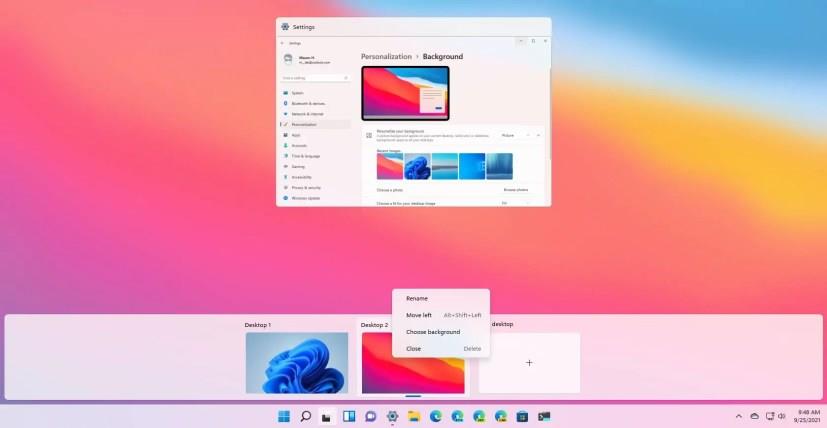
Windows 11 Desktops
The feature works virtually the same as before, but the experience has been redesigned. For example, when you click the Task View button in the Taskbar or use the Windows key + Tab keyboard shortcut, you will find that the Desktops are now available at the bottom of the screen. As before, you will continue to see a list of running applications, but Timeline will no longer be available since it has been removed.
Like the rest of the system experience, the interface follows the same Windows 11 new style designed with rounded corners and semi-transparent materials.
On Desktops, you can reorganize, create, and customize as many virtual desktops as you need, and each one can have a different background to differentiate each space better.
To change the background image, right-click the desktop and select the Choose background option to open the “Background” settings and choose another image file.
The context menu for Desktops also includes options to change the position of the desktop to left or right.
New Snap layouts and Snap groups
As part of the “Snap assist” feature, Windows 11 is introducing two new improvements, including “Snap layouts” and “Snap groups,” to make it easier to organize and work with multiple windows on the screen.
Snap layouts
“Snap layouts” is a feature that, when hovering over the maximize button in File Explorer or other apps, gives you a visual aid to snap windows on the screen using different grids quickly.

Windows 11 Snap layouts
On smaller screens, you will see a set of four snap layouts or six layouts on larger screens. You can also open the snap layouts flyout with the Windows key + Z keyboard shortcut.
While in portrait mode, when snapping windows to the right and left, Snap assist will now position one window at the top and the other at the bottom.
Snap groups
“Snap groups” is a way to switch back quickly to your group of snapped windows when switching to a different app. For example, you can snap together at least two apps. Then if you suddenly switch to another app, you can hover over one of these open apps in the Taskbar to find the snap group and click to switch back.

Snap groups
New Voice Typing app
Windows 11 also has a new Voice Typing app to help you type with your voice. It’s off by default, but you can open it from the voice typing settings or with the Windows key + H keyboard shortcut.

Voice Typing app
The new app has a modern interface and is straightforward. It includes a microphone button to begin typing. And the settings menu lets you customize some options, including the ability to enable an option to launch the experience faster and use auto punctuation.
New Windows 11 File Explorer app
This new version of Windows comes with an updated File Explorer experience. However, it’s not an entirely new application. Instead, this is the same app but with an updated interface.

Windows 11 File Explorer
The design was done using the Windows UI Library (WinUI) that includes new visual elements, animations, and controls that match the style Microsoft is pushing on Windows 11.
Command bar
The new File Explorer ditches the ribbon-style menu in favor of a new minimalist header that combines the title bar and menu into a unified interface that includes the new command bar.
The command bar includes all the new commands to perform the different actions, including Cut, Copy, Paste, Rename, Share, and Delete. And this time around, the icons no longer have labels, which means that you will have to rely on their shape to know the action you want to take.
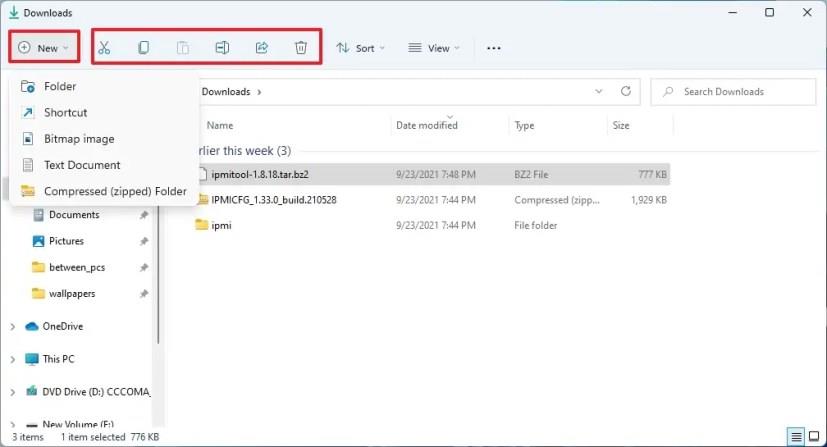
File Explorer command bar
You will also notice the “New” menu that includes all the standard options to create new folders, shortcuts, or documents, which means that you no longer have a dedicated option to create folders. However, you can still use the “Ctrl + Shift + N” keyboard shortcut to create a new folder quickly.
The command bar also includes three new menus, including “Sort and group options,” “Layout and view options,” and “See more.”
The Sort menu houses the options to sort content by name, date modified, type, and more.
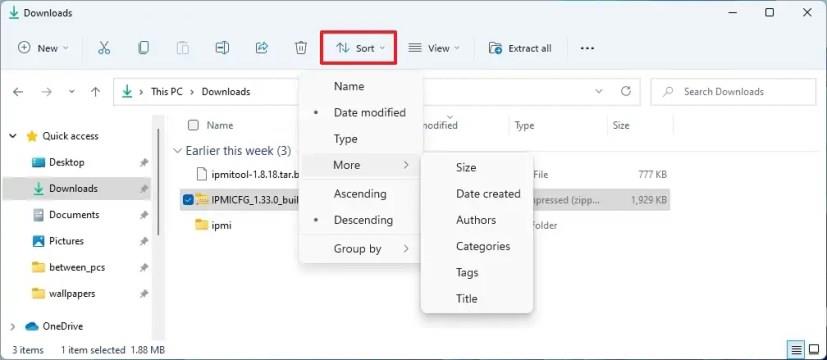
Sort menu
The View menu can show files and folders with different sizes like extra-large, large, small, list, details, tiles, and content. The option to enable the compact view is also located here. The menu also includes the Show submenu that has the options to manage the left pane view, show extensions, or show hidden items.

View menu
Then, the three-dotted is the See more menu that includes the options for selections, compressed to ZIP file, and Options to manage the app settings.
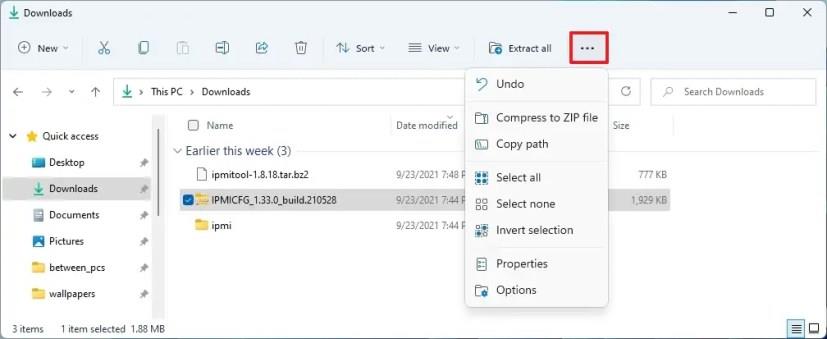
See more menu
These menus will also show different commands depending on your viewing content. For instance, if you are on the “This PC” page, the “See more” menu will also include the options to mount a network drive, but the “New” menu will be grayed out.
Also, if you select a media file like a picture, you will get additional commands like in the legacy version of the app.
Context menu
File Explorer for Windows 11 also introduces a new context menu style. You will see this menu when right-clicking a file or folder. The context menu includes a row with common commands like Cut, Copy, Rename, Share, and Delete, and below, you will find the options you can use with that specific file.
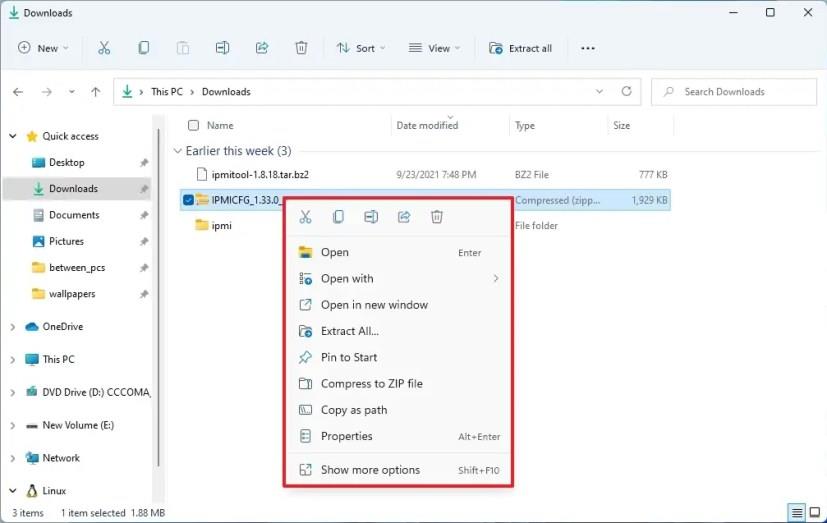
File Explorer context menu
Similar to other elements across Windows 11, the context menu follows the new design language with semi-transparent materials and rounded corners. The legacy menu is still available if you need some of the old options that are not available in the new menu. You can access the legacy view by clicking the Show more options or using the Shift + F10 keyboard shortcut.
The new context menu is also available throughout Windows 11, including for the Desktop context menu.
Scrollbar
File Explorer has a new scrollbar that works the same as before, but it has a thinner design. In the left pane, you will also find a new Linux option. This entry has been designed to give you quick access to Linux files inside distros installed with the Windows Subsystem for Linux.
Share
In this new version, the “Share” interface is getting an update. On Windows 11, when you click the Share button, you will get a new UI with several improvements. For example, you will now see a preview of the items along with the option to enable “Nearby sharing” if it’s not enabled. If the contact you want to send the file or the app is not in the list, you now have an option to select a different app or look up your contacts.

Share UI
New icon
Alongside the new interface, File Explorer also introduces new default icons with new styles, orientations, and colors.

File Explorer new icons
Windows 11 includes new icons for pretty much every element in File Explorer, but the ones you will notice immediately are for the default folders (Desktop, Documents, Downloads, Music, and Pictures). There are three versions for the default folder icon. One shows when the folder is empty, another one slightly different that indicates that folder has files, and you will even find an updated version of the zip folder icon.
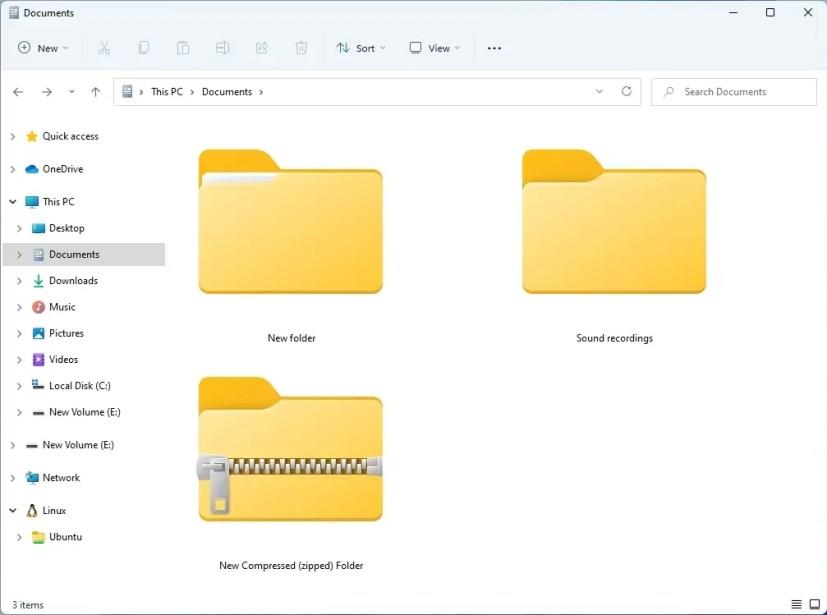
New folder icons
Microsoft has also made icons for other elements like the installation drive, secondary and network storage, This PC, Network, and there are new icons in the “Folder Options” settings.
While the new File Explorer includes many new visual changes, a lot of elements remain virtually unchanged. You will see this when changing settings, using the Format tool, or when trying to mount a network folder.
Other changes with File Explorer for Windows 11 include the “Run with PowerShell” option in the context menu for PowerShell scripts. You will now be able to extract all files from a zip folder that was previously set to online-only content in OneDrive. And when remaining content, it’s now possible to use the CTRL + Delete and CTRL + Backspace to delete words at a time and the CTRL + Left and Right arrow to move the cursor between words within the name.
Clipboard changes and features
Windows 11 introduces a new version of its Emoji Picker that integrates with the clipboard history and supports animated GIFs. This is, in addition, to support for additional languages, kaomoji, and symbols.
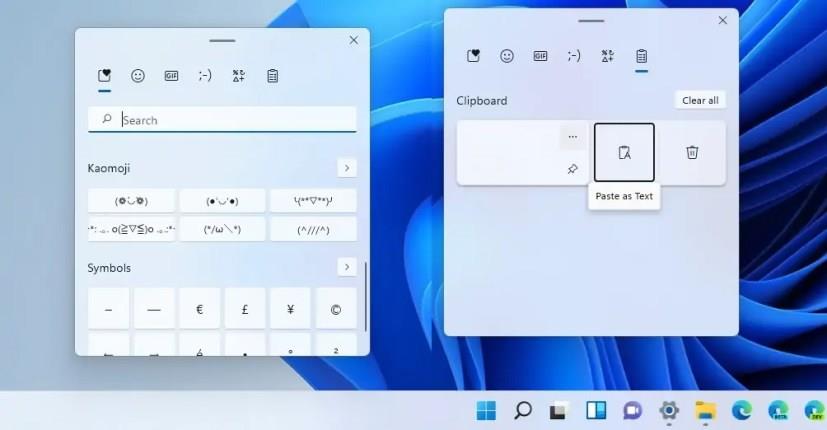
Windows 11 Clipboard UI
The new interface has a modern design using Fluent Design visual elements, such as blur and transparency, and it includes an inline search box to make it easier to discover emojis and animated GIFs.
Since the Emoji Picker is integrating the clipboard history interface, you can now insert emojis and copies from a single experience using the “Windows key + .” or “Windows key +;” or “Windows key + V” keyboard shortcuts.
Starting with this version, you will also find support for Emoji versions 12.1 and 13.0, which brings over 200 new glyphs, and now there are gender-neutral emoji designs.
Furthermore, the clipboard history interface includes options to pin, unpin, delete, paste as text, and individual sync entries.
Finally, if you use the Snipping Tool, when you use the Windows key + Shift + S keyboard shortcut, the capture will now be stored in the Clipboard to paste it on any folder to save the screenshot as a .png file.
Task Manager improvements
As part of the Task Manager improvements, Windows 11 now classifies and shows all the processes from Microsoft Edge. The classification is divided into several elements: Tabs, Browser processes (Browser, GPU Process, Crashpad), Utility plugins (Utility: Audio Service Extensions), and Dedicated & Service workers, and more.
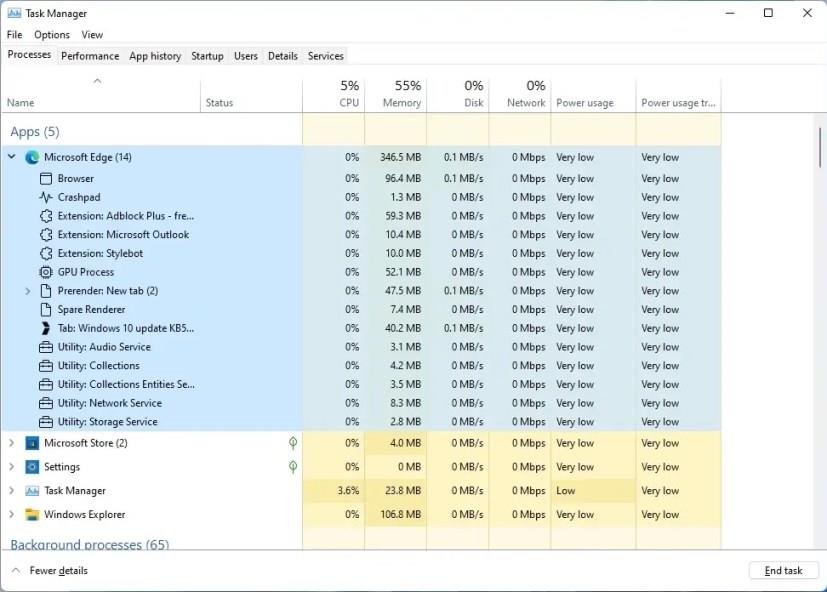
Task Manager Edge classification
You will also see that each process classification is described with an icon to make it easier to identify. If you are viewing a website tab in the processes, it will include the site icon.
Auto-HDR for gaming and DirectStorage
Windows 11 also comes with “Auto HDR for games,” a new feature that has been designed to improve the gaming experience by automatically converting compatible titles from standard-dynamic-range (SDR) to high-dynamic-range (HDR) to unlock the brighter and bolder colors available on compatible displays that use this technology for a more immersive and realistic experience.
Once you enable the feature, you will get a more immersive and realistic gaming experience with an increased range of color and luminance in more than 1000 DirectX 11 and DirectX 12 PC games.
Although this is one of the biggest features on Windows 11, it’s only supported on specific hardware, which means that you will need a monitor that supports HDR. You can use this guide to learn the steps to enable the feature.
DirectStorage is a new technology that allows games assets to load faster to the graphics card without bugging down the processor. In other words, this means faster load times and more detailed game worlds. (This feature will require the latest NVMe drives and optimization by the game developers.)
Also, Windows 11 now supports DirectX 12 Ultimate. DirectX 12 is the technology standard for creating and managing gaming, images, and multimedia (such as visual effects and audio effects) that run on Windows-based devices.
New Windows 11 Settings app
In addition to the new features and changes, Windows 11 also includes a new version of the Settings app. The new experience to customize the look and feel and configure system settings features a new redesigned interface, regroups and integrates new settings, ports more features from Control Panel, removes the homepage, and a lot more.

Windows 11 Settings app
As part of the new experience, the app includes rounded corners, a semi-transparent interface, and modern and colorful icons.
The navigation system is similar to the one available on Windows 10, but now there are more options, and the settings are grouped using different logic.
When you open Settings, you will notice that you are taken directly to the “System” section, and that’s because this version ditches the homepage.
Also, when you open a new section, the pages will be listed on the right side instead of the left.
As you drill down through the pages, at the top, you will find the new breadcrumbs that will indicate your current location in the app. You can click each breadcrumb to jump back to a previous page. The setting pages can also show hero controls for frequently used settings or a specific feature.
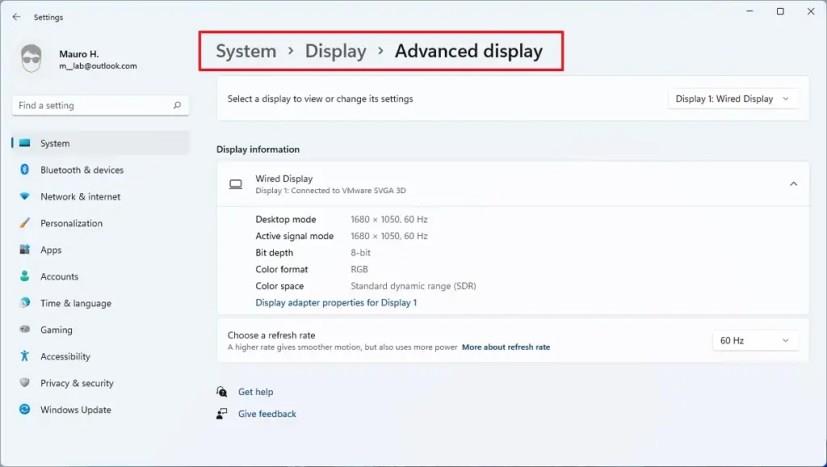
Settings breadcrumbs
Finally, the new Settings app can now recommend settings adjustments based on their current state.
System settings
The System section is the new default page when you open the Settings app. It now includes the pages to adjust many settings, including Display, Sound, Notifications, Focus assist, Power, Storage, Nearby sharing, as well as Multitasking, Activation, Troubleshoot, Recovery, Projecting to this PC, Remote Desktop, Clipboard, and About.
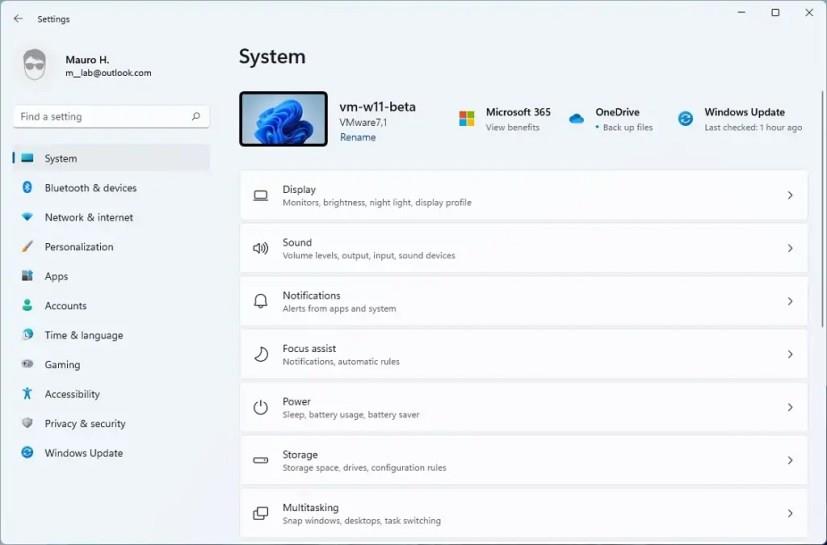
System section
Also, the hero controls in this section include desktop preview, device name, and option to rename the system, and you will find icons with the status of OneDrive and Windows Update.
Display
On the “Display” page, the Scale & layout section introduces new settings to remember window locations based on monitor connection and window locations based on monitor connection to improve the experience when working with more than one monitor.

Multiple displays
These settings are part of a new experience on Windows 11 that allows you to restore apps automatically to their original location when reconnecting an external monitor.
You will notice a new “Automatically adjust contrast based on the display content to help improve battery” option, under the Brightness setting, to disable content adaptive brightness control (CABC) on Windows 11.
In the “Advanced display” page, there is a new option (Dynamic) to enable the new Dynamic Refresh Rate (DRR) feature in the refresh rate setting.
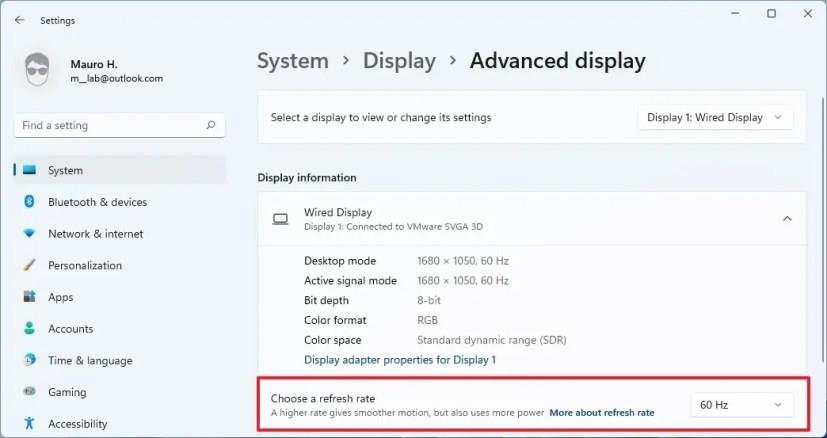
Dynamic refresh rate
If you choose this option, Windows will automatically lower or increase the display refresh rate to reduce the power consumption on supported hardware.
Also, if the display is certified as HDR, you will know this information on this page.
On the “Graphics” page, there is a new search box and list of apps you may want to customize.
Also, the Night light page is not getting new settings, but when turning the night light on or off manually through the Settings app or Action Center, the feature will now turn off immediately rather than using slow transition.
Sound
On the Sound page, you will find an option to enable mono audio for people with difficulty hearing, and there is an option to pair output devices quickly.
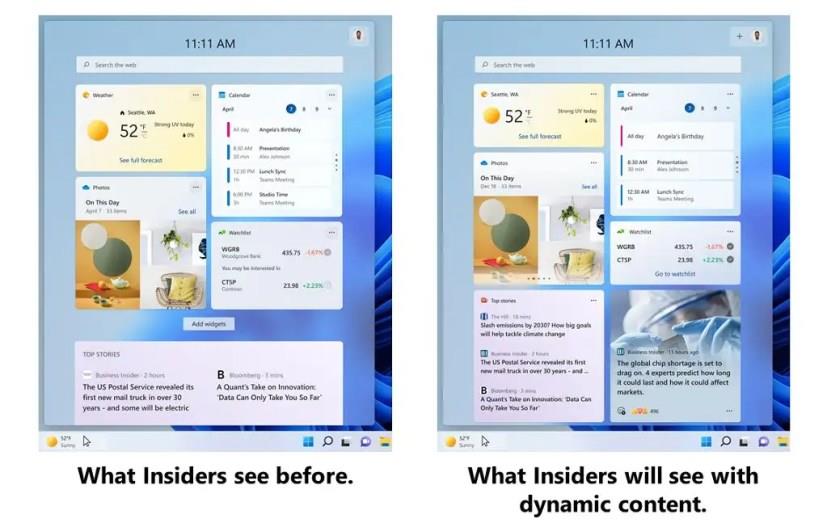
Mono audio
Under the “Advanced” section, you will find a new option to access all the sound devices, troubleshoot, and others.
The “App volume and devices preferences” page has become the “Volume mixer.” The page still has all the same settings, and it replaces the legacy Taskbar volume mixer menu.
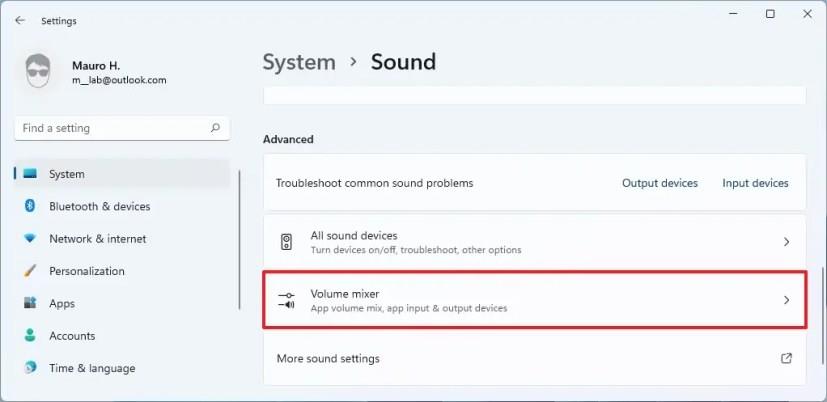
Windows 11 Volume mixer
The Properties page for devices has been redesigned with high-quality icons, driver information, and new settings.
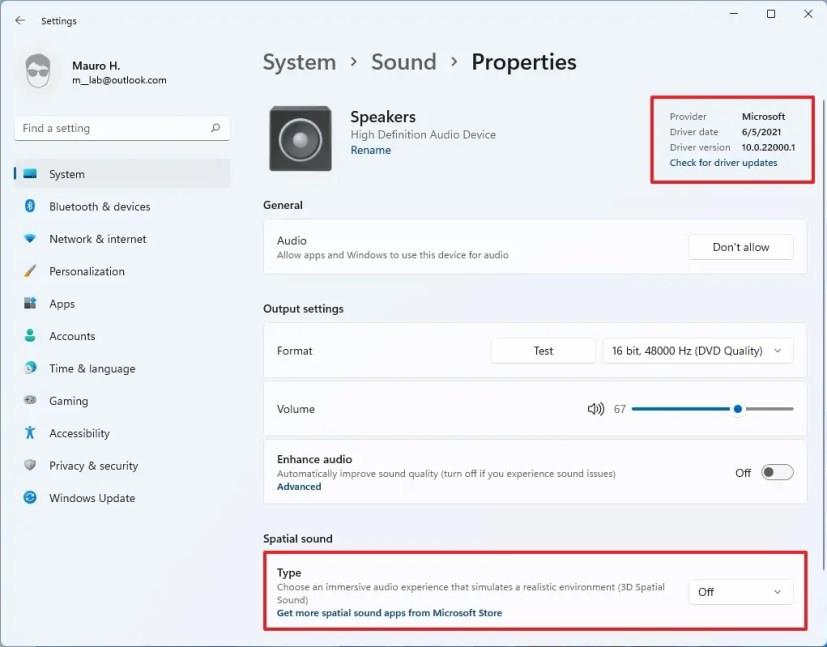
Sound properties
The Speakers page now houses permissions to allow or deny apps access to the output device. You can choose the audio format, adjust the volume, and enable Spatial sound. Also, you can now rename the device, see the driver information, and check for driver updates.
Notifications
On the Notifications page, you only have three settings, and there’s an option to access the “Focus assist” settings page.
Power & battery settings
The Power & battery page now displays the battery usage over time.
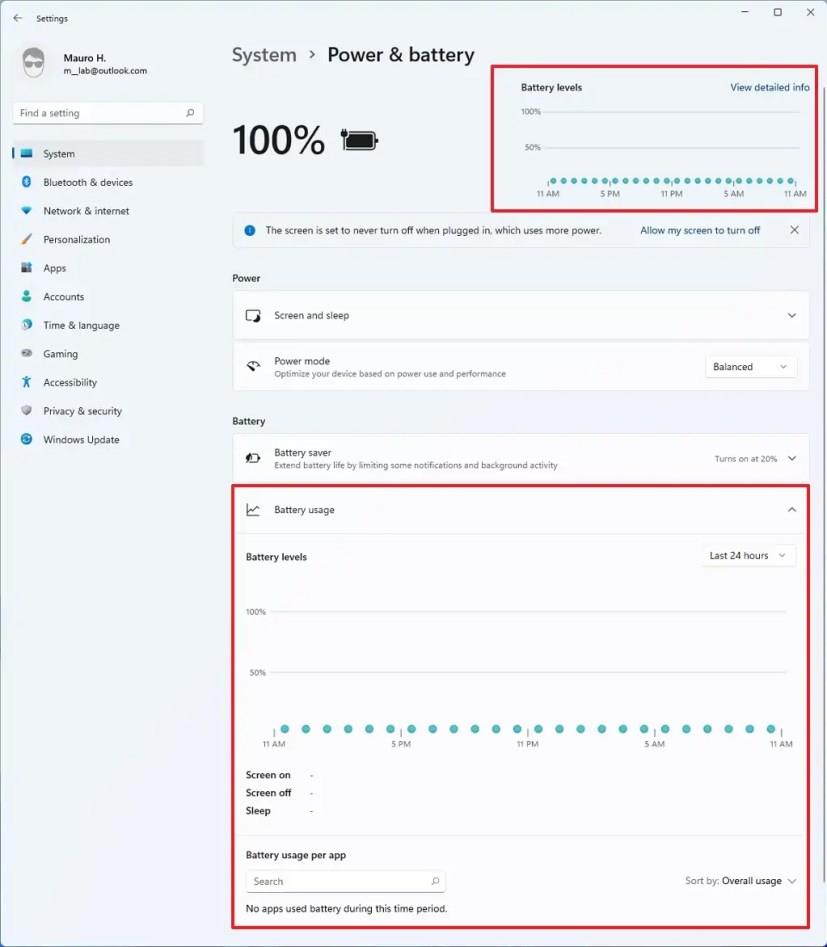
Power & battery settings
Storage
The Storage page has been updated with new features, and the information about the system drive is now front and center.
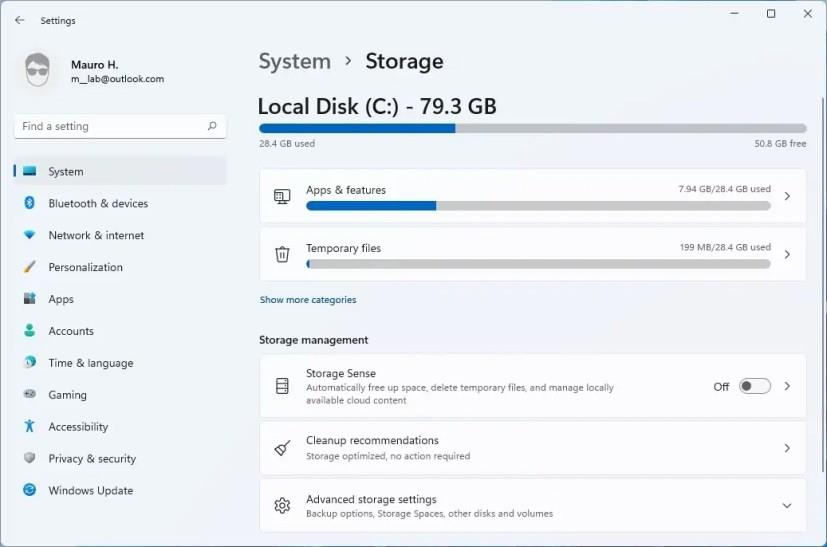
Windows 11 Storage settings
Storage sense is now located under the “Storage management” section. The only change on the Storage sense page is the new option to run the cleanup of temporary files automatically.
The Windows 11 Storage sense has a new feature known as Cleanup recommendations that shows how many large files and used files, synced files to the cloud, unused apps you can uninstall, and the temporary files you can delete to free up space.
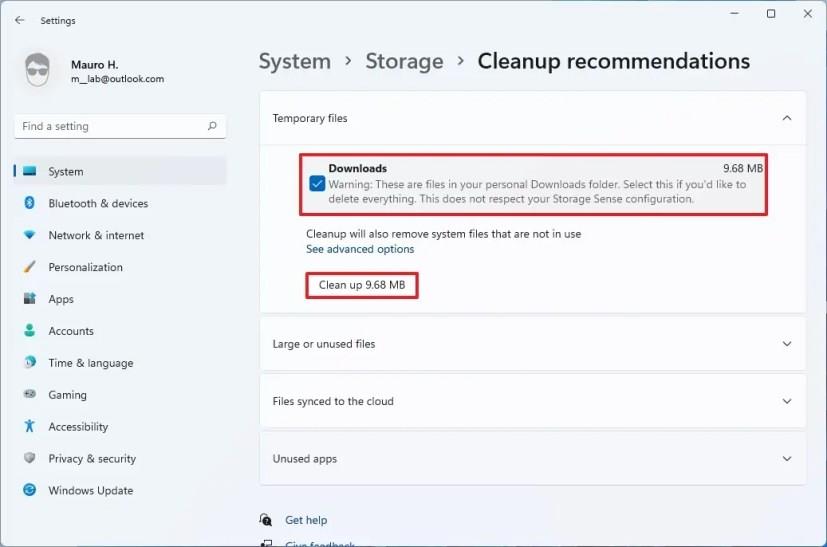
Cleanup recommendations
The feature is straightforward. You only need to select the items and click the “Clean up” button to free up additional space.
In the “Advanced storage settings” section on the main Storage page, you will find the new Disks & Volumes feature that replaces the legacy Disk Management experience.
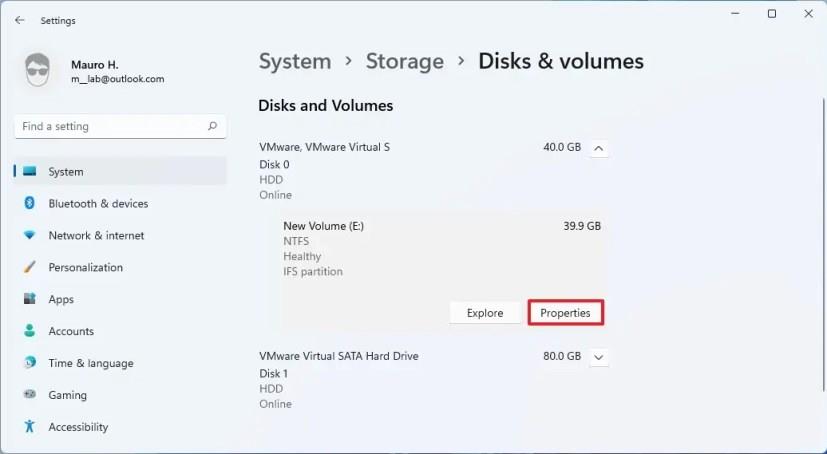
Disks and volumes
Windows already has a tool to manage disks and volumes, but it’s an old control panel experience. The new experience was built from the ground up with modern improvements and accessibility in mind. It also features better integration with features, such as Storage Spaces and the Storage breakdown page.
Like the legacy tool (which is still available), the new tool allows you to view all the drives connected to the device, and you can create, resize, format, and change letters for partitions.
On the page, the disk tool shows all the drives connected to the device with basic information, such as the disk number, media (SSD or HDD), and whether if the drive is online or offline.
You can select the drive and click the Properties button to give you additional information like name, identification, model, media, capacity, and type. You’ll also see the current status and the partition style (for example, GUID Partition Table “GPT”).
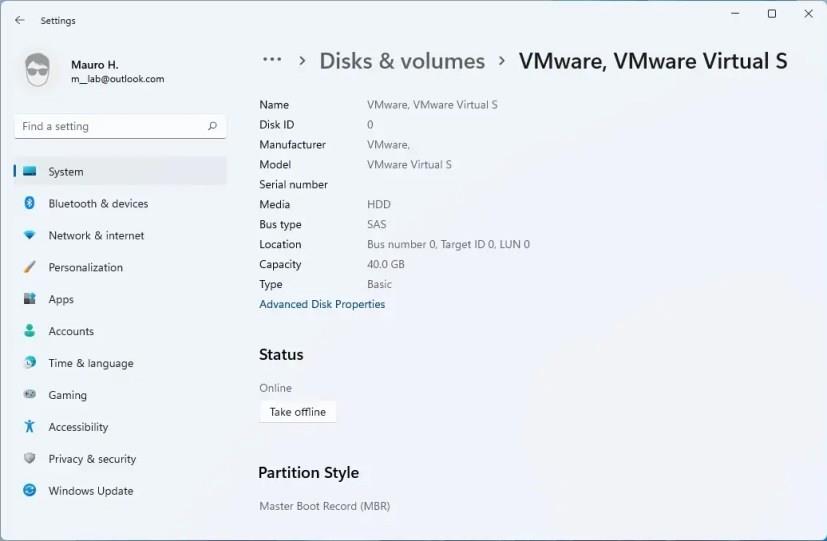
Hard drive information in Settings
The Advanced Disk Properties option opens the properties of the drive with the Control Panel.
While on the main page, if you expand the drive, you will see the list of partitions with rich details, including the file system, partition type, status, and more.
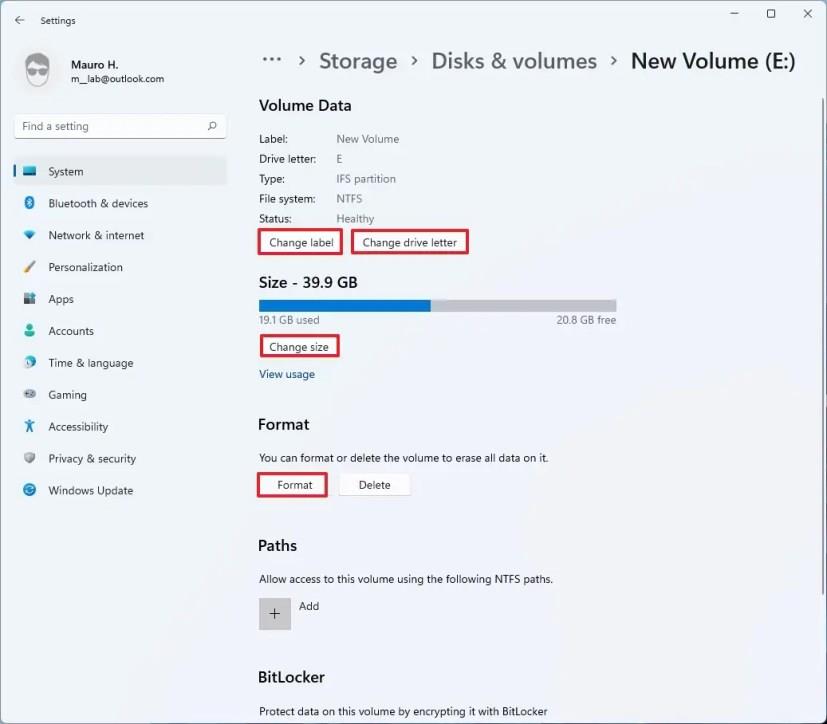
Settings partition info and tools
In addition, the experience includes a health monitor feature to keep tabs on the health of Non-Volatile Memory Express (NVMe) Solid-State Drives (SSDs).
If there is an issue with the drive, you will see a notification to view more details and access the drive to back up the data before it’s too late. The notification will open the drive page, where you can find more information, including the life remaining on the drive, temperature, and available space.
You can select each drive, and clicking the Properties button will access another page where you can change the label or drive letter. You can resize the partition with the Change size button. You can add a path to the volume, and you can even enable BitLocker on the drive.
If you are dealing with an external drive, the properties page will also include options to delete and format the partition, and you can bring the drive online or offline.
Windows 11 is also bringing Storage Spaces to the Settings app. This means you can now create and manage storage pools and spaces, add and remove drives, and optimize pools within the Settings app without opening Control Panel or PowerShell.
Multitasking
On Windows 11, the Multitasking page includes the options to enable and disable Snap layouts, Snap groups, and more.
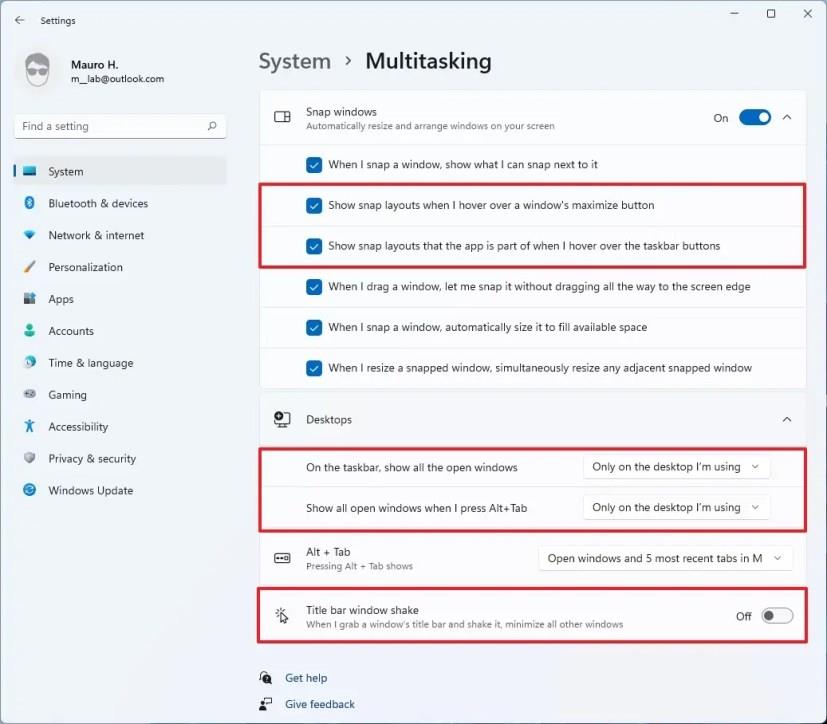
Multitasking settings
Also, the “Virtual Desktops” settings have been renamed to “Desktops,” and the settings are all the same ones as before. And now, the Settings app includes an option to enable or disable the title bar window shake (Aero shake) feature.
Bluetooth & devices settings
The Bluetooth & devices section has also been updated to make it easier to connect peripherals to Windows 11. This section includes the settings to control Bluetooth, Devices, Printers & scanners, Your Phone, Cameras, Mouse, Touch, Pen & Windows Ink, AutoPlay, and USB.
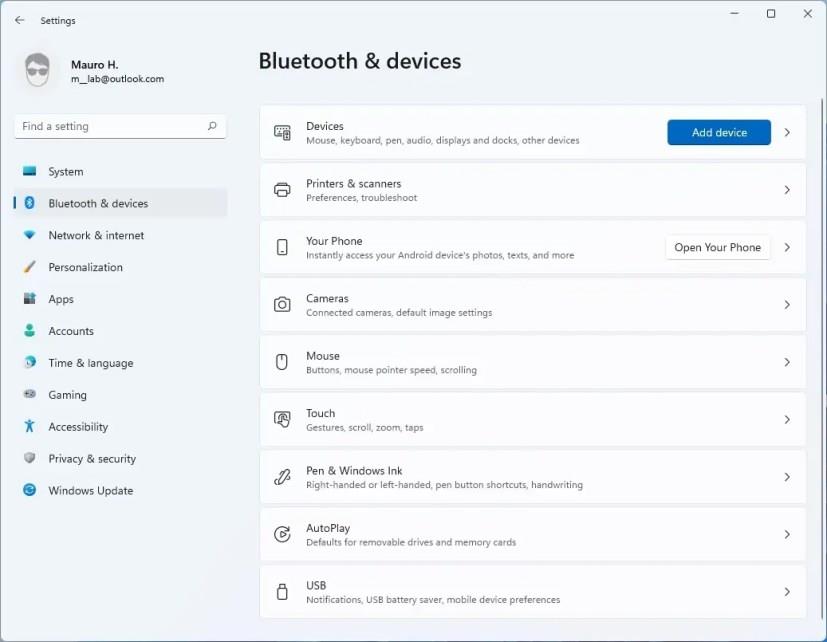
Bluetooth & devices settings
Devices
On the Devices page, you will see a list of the input, output, and other devices connected to your computer. And the Add device will open the wizard to install new peripherals like on Windows 10. If you no longer need a device, you can remove using the peripheral’s menu on the right side.
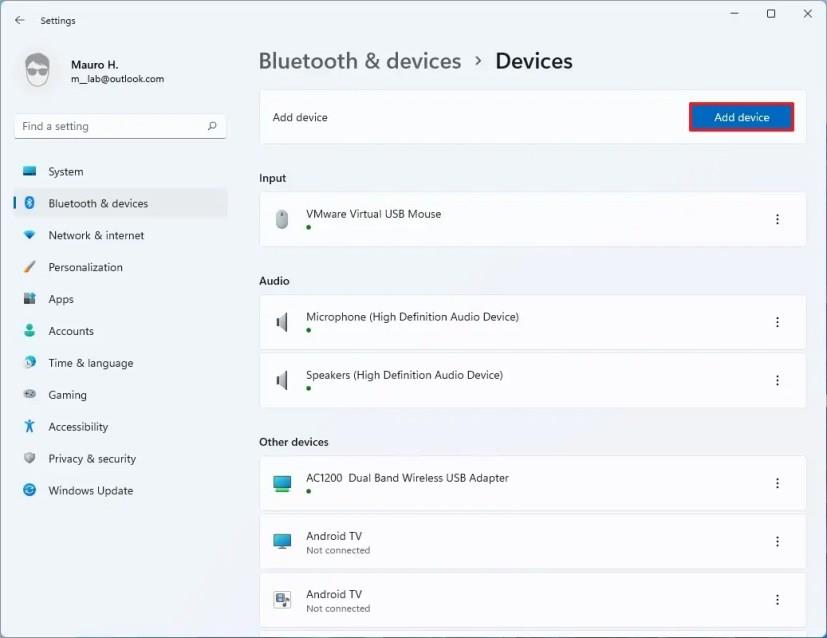
Windows 11 Devices settings
This used to be the “Bluetooth & other devices” page.
Cameras
The Cameras page is new to Windows 11, and it houses the settings to manage webcams and network cameras.
Camera settings
You can manage features like brightness, contrast, rotation settings, and even enable or disable Video HDR and Eye Contact in the camera settings. The Video HDR and Eye Contact features are only available in supported hardware.
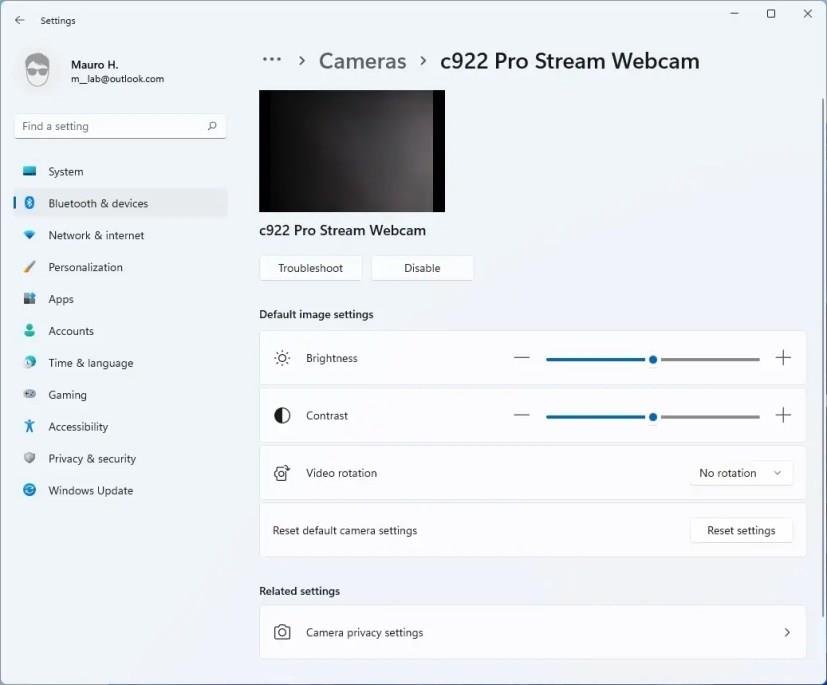
Webcam configuration
Touch
The Touch page is also new, and it’ll be available on devices with touch screens.
Network & internet settings
In the Network & internet section for hero controls, you will see the active network connections, connection properties, and data usage. This part of the Settings app includes the settings for Ethernet, Wi-Fi, VPN, Mobile hotspot, Airplane mode, Proxy, Dial-up, and Advanced network settings.
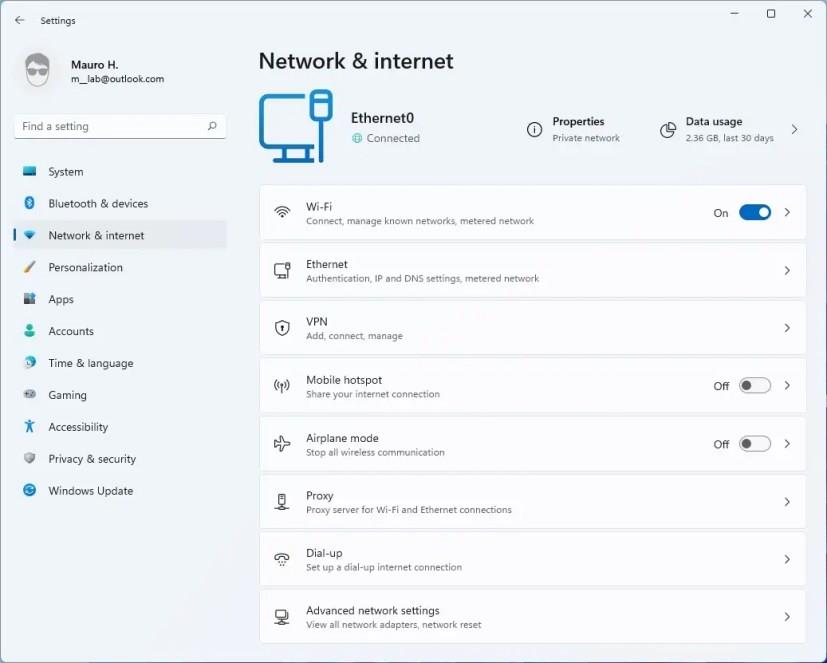
Windows 11 Network & internet
Wi-Fi
The Wi-Fi page isn’t new, but it has been tweaked with an option to view the available wireless networks within the app.
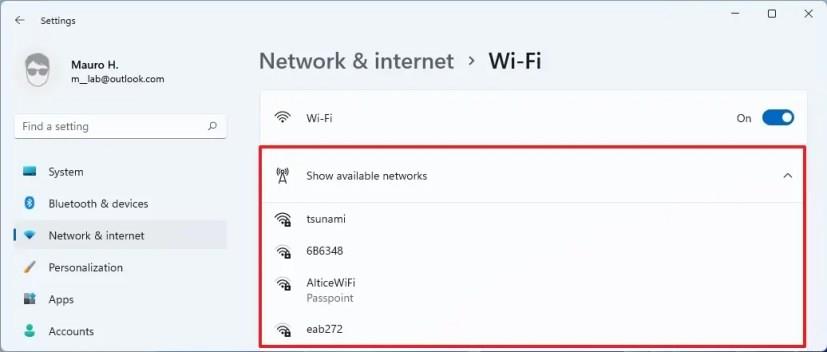
Windows 11 Wi-Fi settings
Ethernet
The Ethernet page now includes an option to set up IEEE 802.1x network authentication settings. (In previous versions, this needed to be done in Control Panel.)
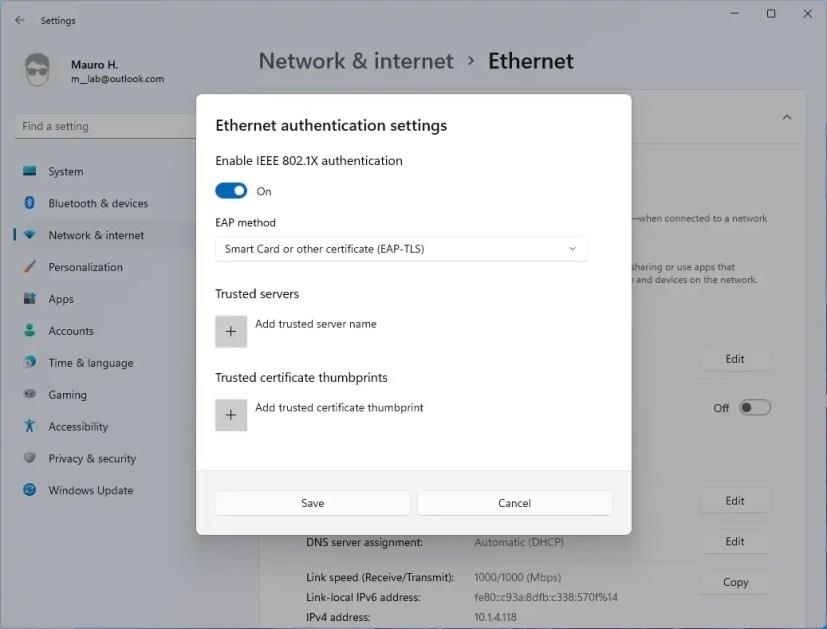
IEEE 802.1X authentication
You can now configure Domain Name System (DNS) without opening the Internet Protocol (IP) configuration page.
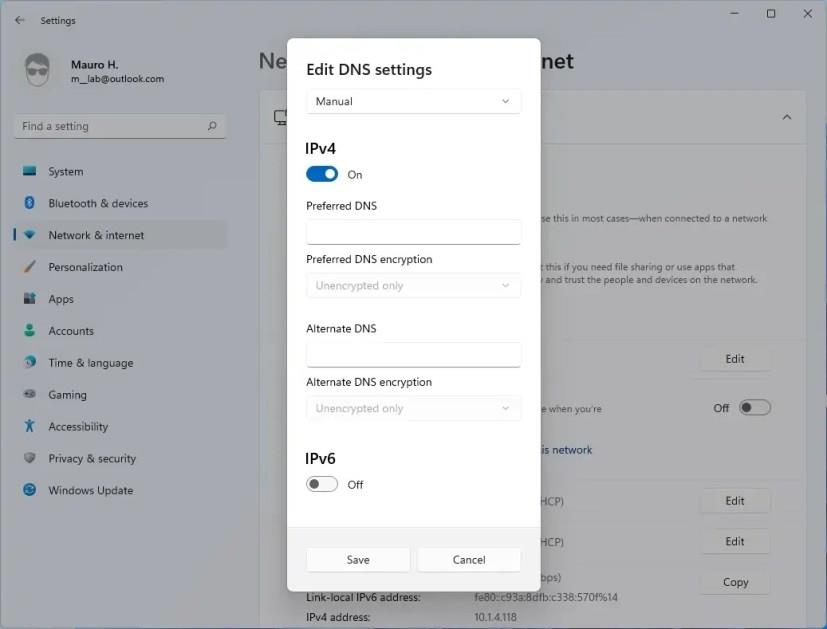
Windows 11 DNS only settings
Finally, starting on Windows 11, you can configure DNS over HTTPS (DoH) to encrypt DNS queries using the Hypertext Transfer Protocol Secure (HTTPS) protocol.
Advanced network settings
The Advanced network settings page is new, and it includes the options to enable or disable, rename, and view the status of network adapters. (In previous versions, this needed to be done in Control Panel.)

Advanced network settings
Personalization settings
While the Personalization section is not new, it has a lot of improvements. For example, the section now shows the six new default themes and a preview of the desktop as hero controls, and it houses the settings for Background, Colors, Themes, Lock screen, Touch keyboard, Start, Taskbar, Fonts, and Device usage.

Windows 11 Personalization settings
Themes
The Themes page is almost identical to the previous version, with the difference that it includes six new default settings.
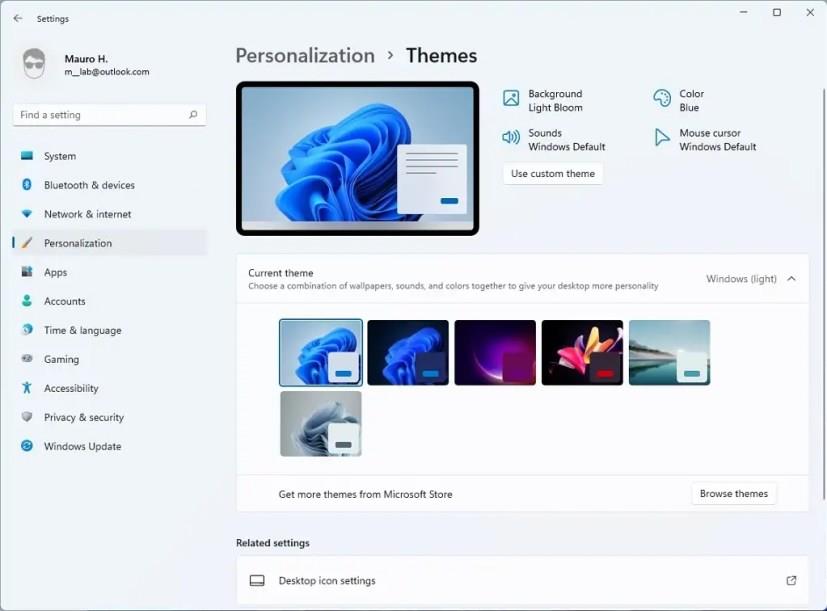
Themes settings
On the Sounds page, you will also find that the “Play Windows Startup sound” option is now enabled by default, and this is because Windows 11 is also bringing back the startup sound again. However, the Windows startup sound will not play after the computer reboots automatically to apply updates.
In addition, you will now find new default sounds for pretty much every action in the latest version of Windows. Microsoft has been created a slightly different sound theme when using the dark mode.
Windows 11 startup sound
You can check out the new sounds by selecting each event and pressing the Test button.
Touch keyboard
The Touch keyboard page is new and houses the settings to adjust the on-screen keyboard, including settings to change the keyboard size, theme with the option to show background and change the size of keys.
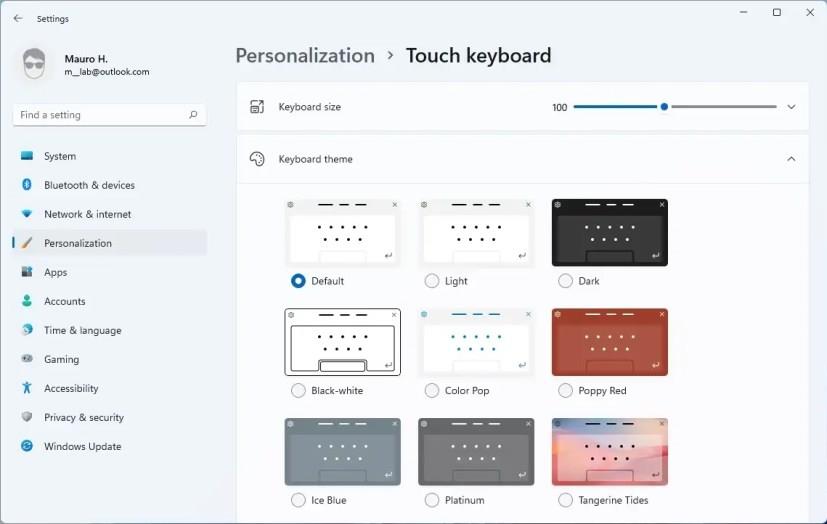
Touch keyboard settings
Start
The Start page includes the new settings to customize the Start menu. For instance, you will now find the options to show or hide recently added and most-used apps. You can also control whether or not to show items in the jump list and the “Recommended” section.
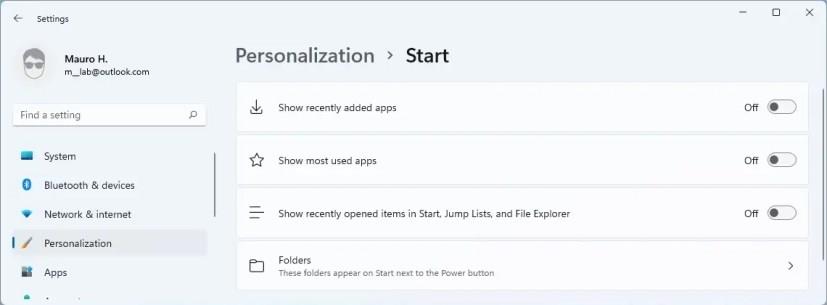
Start settings on Windows 11
In addition, the Folders setting lets you decide what folder (or quick links for File Explorer, Settings, etc.) appear next to the profile menu in the Start menu.
Taskbar
The Taskbar page no longer includes the options to change the Taskbar location, height, or icon size. Instead, the settings reflect the new features, including showing or hiding the Search, Task View, Widgets, and Chat buttons.
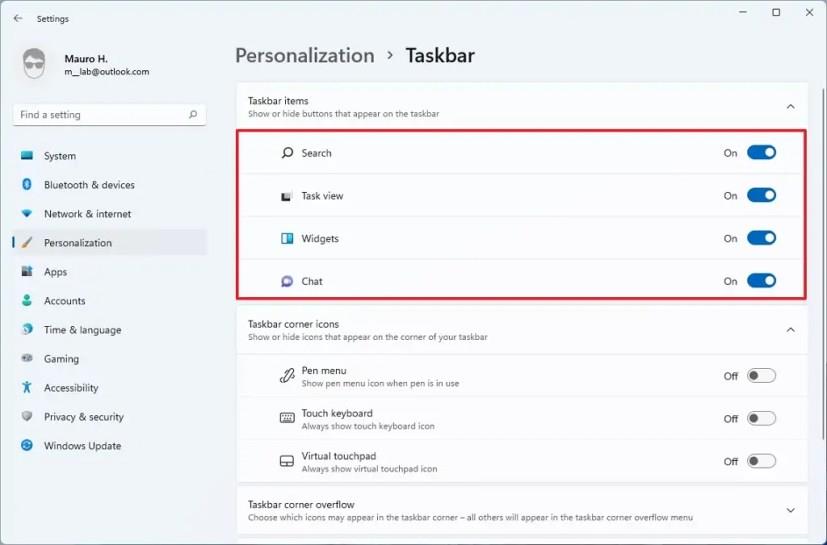
Taskbar settings
You can show or hide the “Pen menu,” “Touch keyboard,” and “Virtual touchpad” buttons that appear in the system tray. Also, you can control which items appear in the overflow menu.
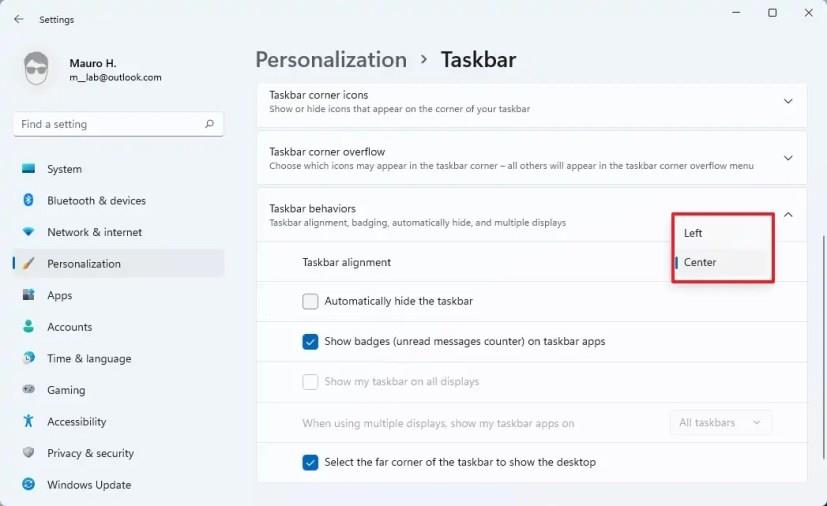
Taskbar behaviors
Finally, in the “Taskbar behaviors” settings, you can change the Taskbar alignment to the left and center. You can also enable auto-hide the Taskbar, show badges for unseen messages, disable the show desktop button, and control the experience in a multiple display setup.
Device usage
The Device Usage is new, and it lets you specify how you plan to use the computer so that Windows 11 can tailor the ad experience.
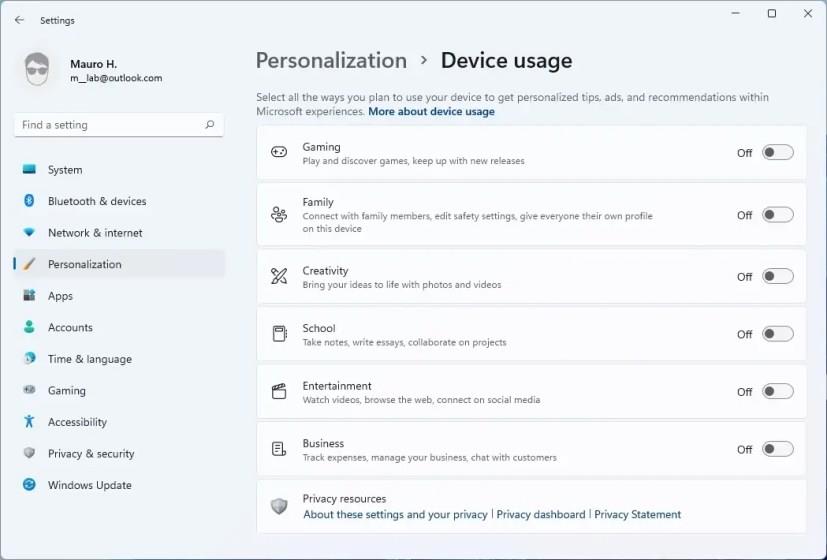
Device usage
Apps settings
The Apps section includes the settings for Apps & features, Default, Offline maps, Optional features, Apps for websites, Video playback, and Startup.
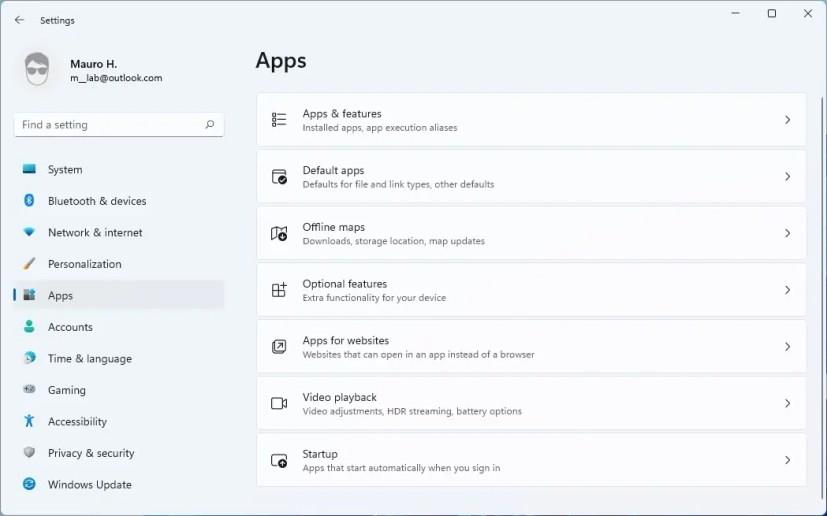
Windows 11 Apps settings
Apps & features
The Apps & features page is not changing significantly, but you will find a new “Share across devices” feature, allowing you to pick up an app you left off on another device.
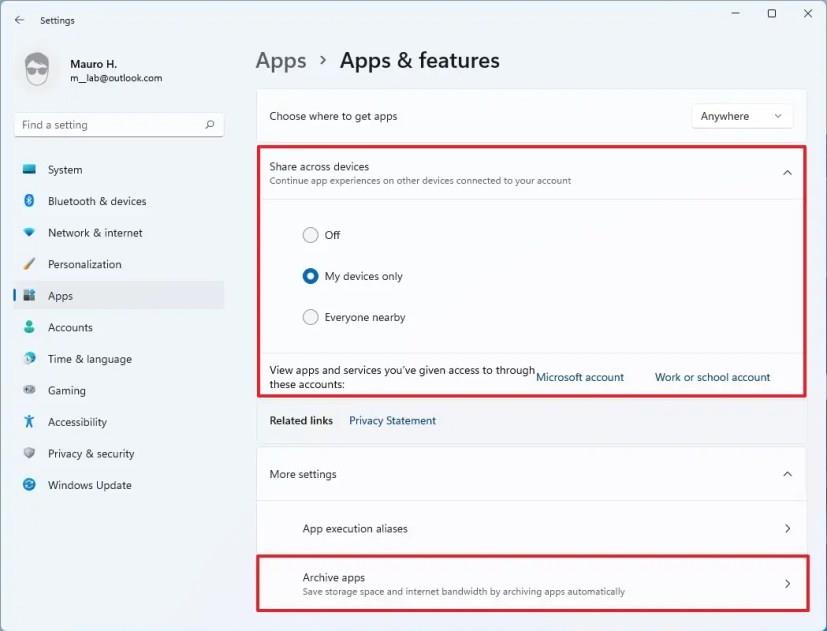
Apps & features settings
When you select “More settings,” you will notice a new Archive apps feature.
The feature is meant to archive apps you don’t often use to save space and internet data. The next time you try to open the app, it’ll connect to the internet and download the full version again. Of course, this is if the app is still available in the Microsoft Store.
Optional features
The Optional features page used to be part of the “Apps & features” page, but it’s now a separate page.
Accounts settings
The Accounts section displays the current user information, OneDrive, and Microsoft Bing rewards details for hero controls. As part of the settings, in this section, you will find the settings for Your info, Email & accounts, Sign-in options, Family & other users, Windows backup, and Access work or school.
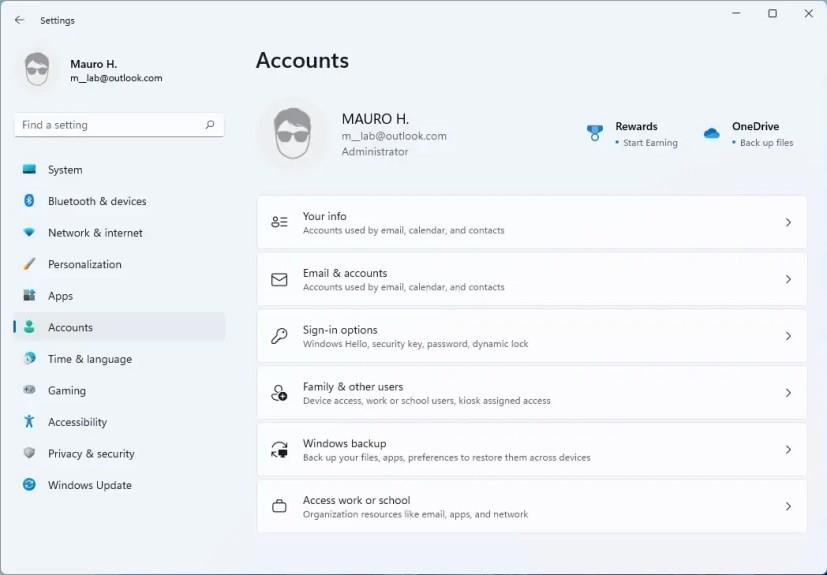
Windows 11 Accounts settings
Windows backup
The Windows backup page is new to Windows 11 and includes the settings to control the OneDrive folder syncing and sync app and system preference settings to the cloud.
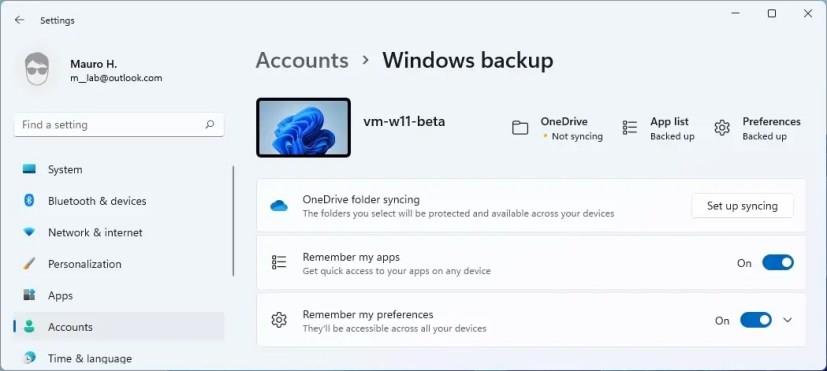
Windows Backup settings
For control heroes, you will see the status for “Preferences,” “App list,” and “OneDrive backup.”
Time & language
The Time & language section includes the settings for Date & time, Language & region, Typing, and Speech pages.

Windows 11 Time & language
Typing
The Typing page isn’t new to Windows 11, but the settings were located in the “Devices” section.
Accessibility
Formerly known as “Ease of access,” the Accessibility section houses the settings Text size, Visual effects, “Mouse pointer and touch,” Text cursor, Magnifier, Color filter, Contrast themes, Narrator, Audio, Captions, Speech, Keyboard, Mouse, and Eye control.
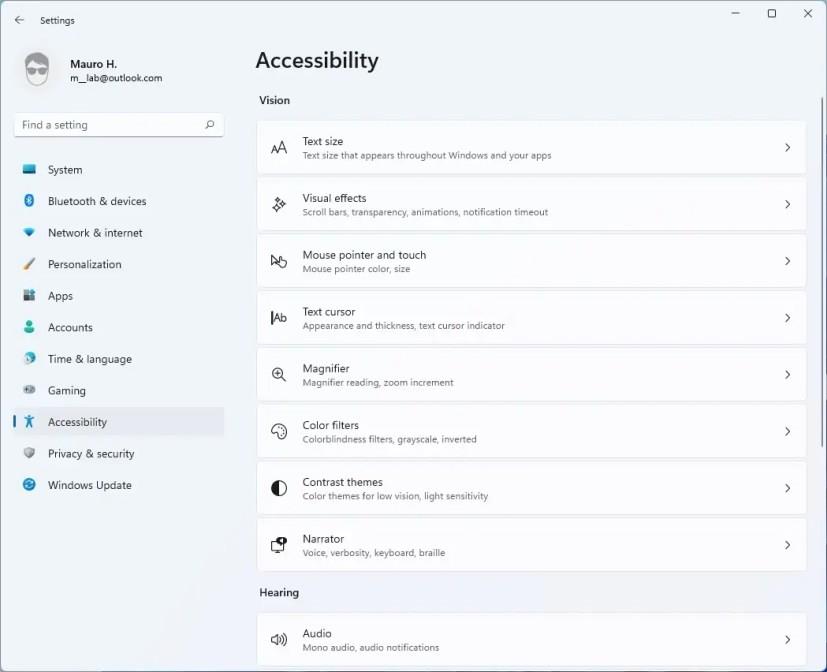
Windows 11 Accessibility settings
Visual effects
The “Display” settings page has now been renamed to “Visual effects,” and the settings are the same as before.
Mouse pointer and touch
The “Mouse pointer” page has been renamed to “Mouse pointer and touch,” and the settings are the same as before.
Privacy & security
On Windows 11, the “Privacy” page has been renamed to “Privacy & security.” This page includes the settings for General, Speech, Inking & typing Personalization, Diagnostic & feedback, and Activity History. Also, in this area is where you will now find Search permissions and Searching Windows pages.
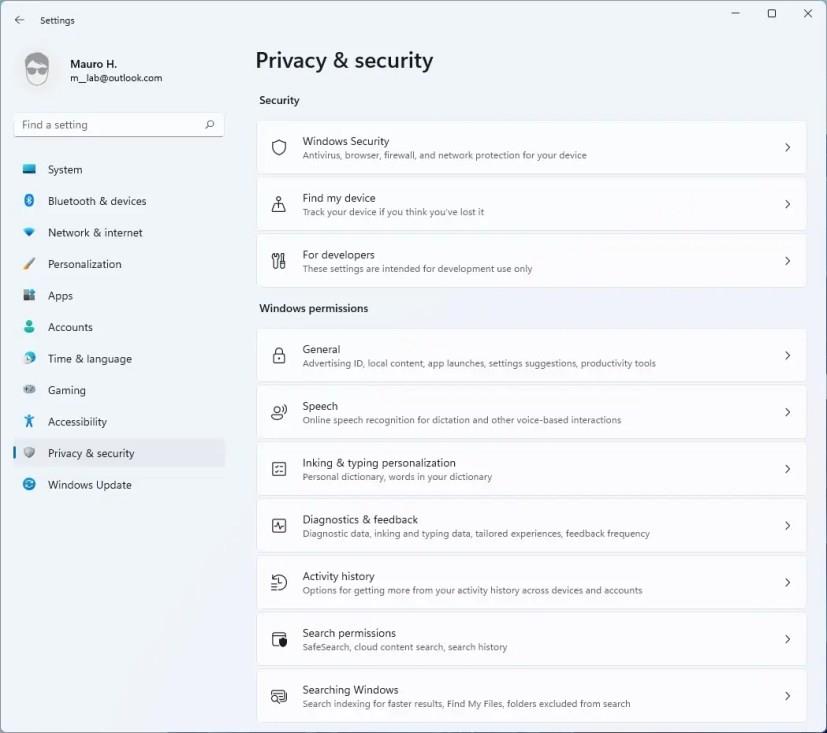
Windows 11 Privacy & security settings
Since this section also includes security settings, you will find the Windows Security, Find my device, Device encryption, and For developers pages.
Screenshot borders
On Windows 11, the Screenshot borders page is new, and it allows you to control if apps can choose to access the screenshot borders.
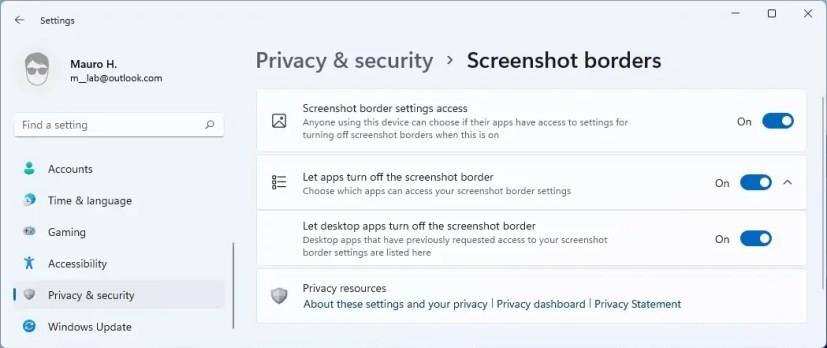
Screenshot borders settings
Screenshot and apps
The Screenshot and apps page is new for this release, and it includes the settings to decide which apps can grab screenshots.
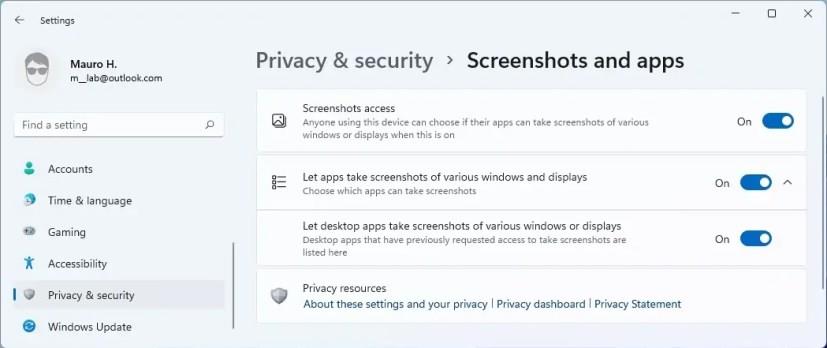
Screenshots and apps settings
Windows Update
The Windows Update section is a new section on Windows 11. The page now includes colorful icons and improvements to communicate the status of updates better. Also, in this section that’s where you will find the settings to view the Update history, access the Advanced options, and enroll a computer in the Windows Insider Program.
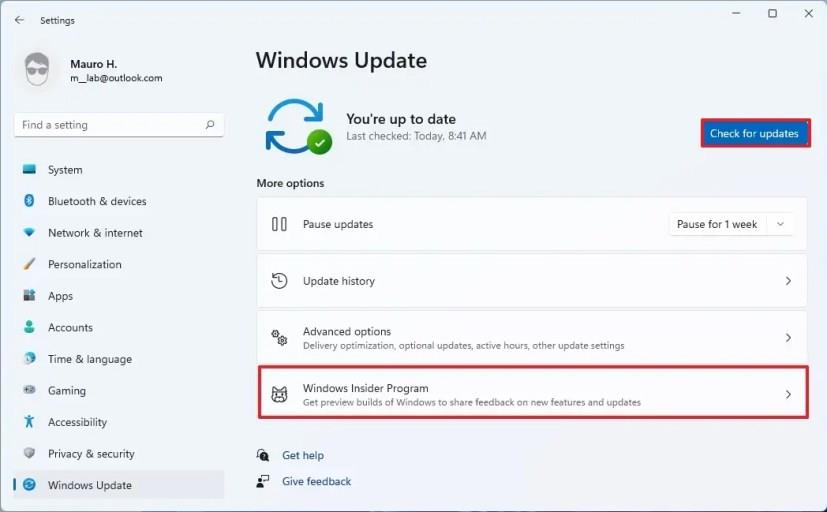
Windows Update settings
In addition, when a new update is ready for your device, the Settings app will inform you how long it will take to apply it. However, this feature is only available for Solid-State Drives (SSD) devices.
Advanced options
The Advanced options page now includes a Configured update policies page that shows all the Group Policy policies currently applied to the device.
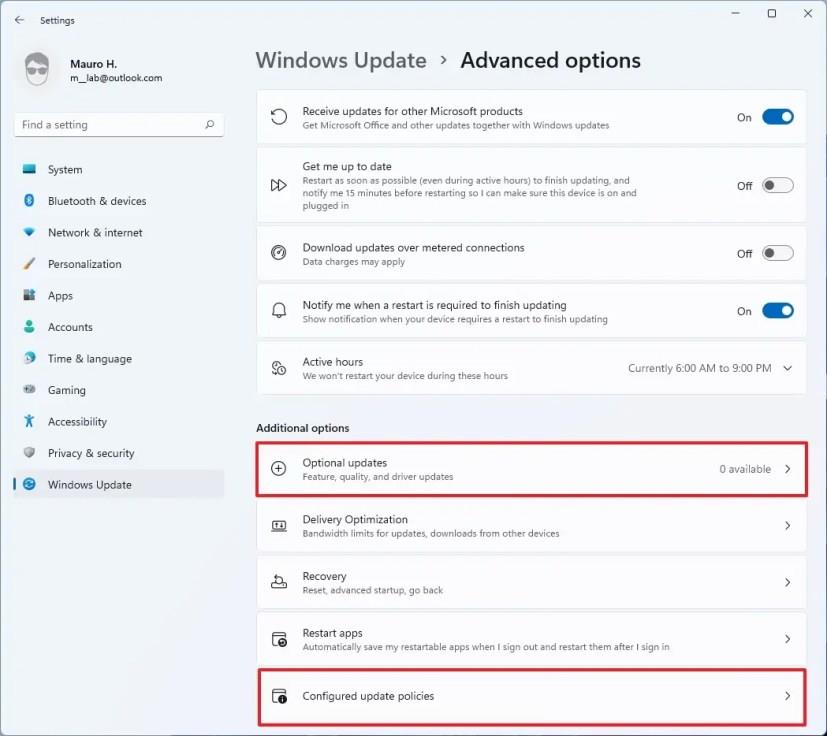
Advanced options
Also, on this page, you find the page to view and install optional updates available for your device.
Language updates
The Scottish Gaelic keyboard now uses AltGr + 7 to input ⁊ (U+204A TIRONIAN SIGNET), pressing’ will now insert the characters, and Alt Gr +’ now acts as a dead key to add the acute accent with a subsequent letter.
Also, when pressing Shift + 6 will now insert ߾ (U+07FE ), and pressing Shift + 7 will now insert ߿ (U+07FF) for the N’Ko keyboard layout.
Japanese IME improvements and touch keyboard
Windows 11 updates the new Japanese IME to support switching between Hiragana and Katakana using CTRL + CAPSLOCK and ALT + CAPSLOCK (respectively), as it was supported with the previous version.
Microsoft is also introducing the “50-on touch keyboard” layout for the Japanese language. This is a popular layout that allows you to input Japanese texts intuitively without knowing how to compose Hiragana characters.
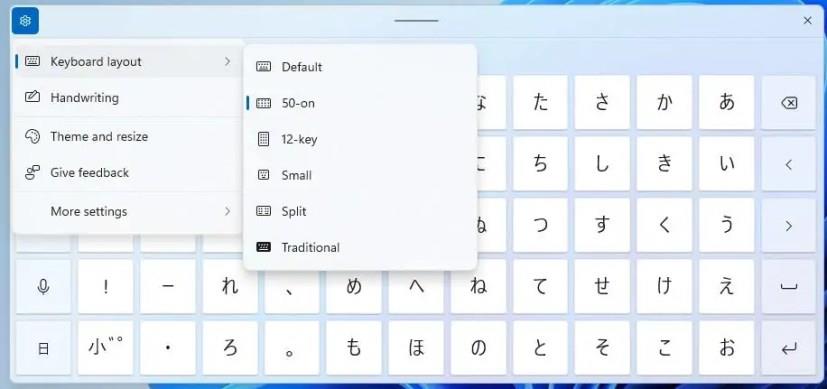
Japanese 50-on keyboard layout
You can use the new layout by clicking the Settings button and selecting the “50-on” option. It also provides alphabet and symbol views newly explicitly designed for the layout.
Input Method Editor (IME)
Microsoft is introducing a new version of all available IMEs that includes a new modern design using the Fluent Design System, including acrylic background, selection visual, and dark theme support.
There are some font adjustments in the candidate interface to minimize intrusiveness while securing visibility. Also, the new design is expanding to more languages.
Also, in this version, Windows integrates the new IME candidate windows design for Japanese, Chinese Traditional, and Indic IMEs.
Korean IME improvements
If you type in Korean, you’ll also find a new version of the Korean IME with improvements in the typing experience.
Windows Subsystem for Linux (WSL) new features
Windows 11 ships with an updated version of the Windows Subsystem for Linux (WSL) that supports the ability to install Linux GUI (graphical user interface) apps as if they were natively installed on Windows.
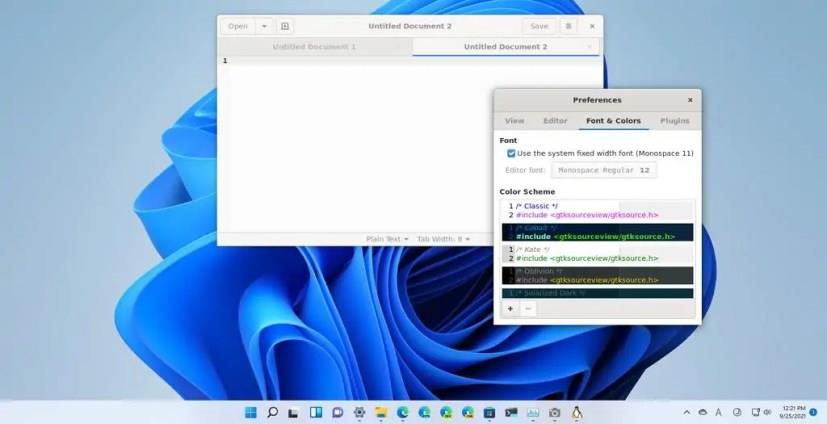
Linux GUI apps on Windows 11
In other words, you can now use your favorite Linux editors, tools, and applications on Windows 11 without the need to switch devices or create a virtual machine.
The feature is meant to develop and test your apps on Linux, but you can use this implementation for any situation. The Linux GUI apps on Windows even include support for speakers and microphones, which means that if you install a media app, the peripherals will pass through and appear in the app. GPU accelerated 3D graphics are also supported to run any app that needs to do complex 3D rendering leveraging OpenGL.
When using this feature, you do not have to run an X server manually since WSL automatically starts a new “companion system distro,” which includes a Wayland, X server, pulse audio server, and all the required components. After you close the app and the WSL session, the system distro will end automatically.
Once the Linux GUI app is installed, it will register in the Start menu, which means that you can launch the app by typing the name on the Windows Subsystem for Linux (WSL) console, or you can launch it like if it was any other application using the Start menu.
If you launch the app from the Start menu, you will find the entry in the “Recently added” list, and you can find it inside the (distro name) folder below the Linux distro entry.
You will also notice that the Taskbar will show the icon with a Linux logo, indicating that you are not running a Windows 11 application.
The experience using a graphical Linux app on Windows 11 feels native, but it’s not. The app renders with all the Linux visual styles for the frame, menus, and other elements, and there is even a shadow around the frame, and every window works independently. However, it is a remote desktop connection, which Microsoft is likely leveraging with the RemoteApp feature built into the operating system.
File Explorer with Linux integration
Also, in WSL, the default path has been changed to \\wsl.localhost\\ from \\wsl\\ to improve reliability and performance. However, you will still be able to use the \\wsl\\ path to access the files.
New WSL install and other changes
The Windows Subsystem for Linux is also getting a few more features, including GPU compute, wsl --install command, and wsl --update command.
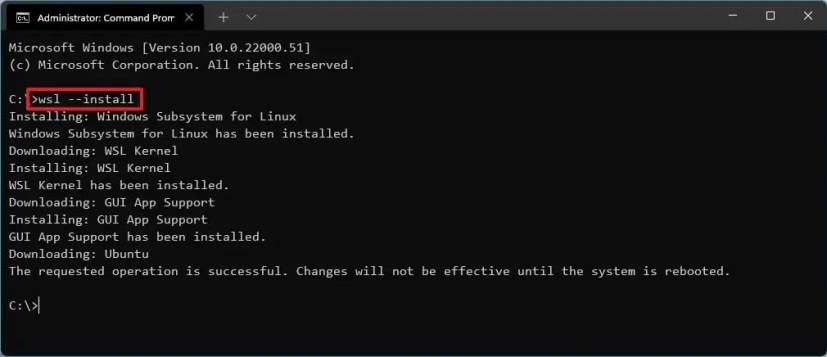
Windows 11 install WSL command
The GPU compute is a feature that allows the Linux binaries to leverage graphics cards, making it possible to perform more machine learning development and data science workflows directly in WSL.
The wsl --install command lets you install the WSL components aster, and the wsl --update command gives you the ability to manage the Linux kernel version used by WSL 2 distros.
The custom Linux kernel from the Windows system image has been removed, and it’s now available through the Microsoft Store.
On Windows 11, you can now attach and mount physical drives inside the Windows Subsystem for Linux distros. The feature enables you to access file systems that are not natively supported (for example, ext4). This means that if you have a dual-boot system with Windows 11 and Linux and are using different drives, you can now access your Linux files from Windows 11.
Also, there is a new option to run Linux commands on the startup of a Windows Subsystem for Linux (WSL) distro.
If you want to use this feature, you will need to edit the /etc/wsl.config file on the distro and adding an option named “command” under the “boot” section.
Windows 11 new system optimization and enhancements
Yes, Windows 11 makes laptops and desktop computers a lot faster. Alongside the redesigned experience and new features, the new version also introduces several under-the-hood improvements to utilize resources better to make the system more responsive.
Snappier and more responsive
For example, under heavy load (even at 90 or 95 percent), Windows 11 will redistribute the compute resources to launch without any lag when launching an app.
This technique also applies to the Windows shell itself, the browser, and your open tabs, but using Sleeping tabs, reducing around 32 percent of memory and 37 percent of processor usage.
When you combine all these new improvements will result in longer battery life and better performance.
Faster resume from sleep mode
Microsoft has also been working to make resume from sleep mode faster. This was possible because of the optimization done for calling hardware components that have to turn on to resume from sleep to improve memory management.
In addition, at the software layer, Windows 11 is making code changes that translate to around 25 percent faster resume times. Using these new techniques, Microsoft claims that most users will resume their devices from sleep “almost instantaneously,” and the device can “stay in sleep state longer and not hibernate as often.”
Faster Windows Hello sign in
Windows 11 also ships with “code optimization” that makes the Windows Hello sign-in process up to 30 percent faster as part of the performance improvements.
Reduced system footprint
Furthermore, Windows 11 reduces the overall footprint. This was done by expanding the use of compression technologies. Also, non-critical built-in apps and other components (such as Microsoft To Do, Sticky Notes, Power Automate) their default state is now “stub” that also reduces the space on the hard drive, background download activity, and download traffic.
And Windows 11 also reduces the storage consumption caused by the system and browser caches.
Smaller and faster updates
After installing Windows 11, you will notice that updates will download and install faster. This is because Windows includes several optimizations to the update engine, which improves how updates are packaged.
For example, when a new update is released, Windows 11 will compare the components available in the computer and then only pulls down the necessary changes, making updates up to 40 percent smaller.
Also, instead of two, Microsoft is now planning to only release one feature update per year.
First-run experience
The new OS introduces a new first-run experience using the updated “Tips” app to highlight the most significant changes after a major feature update installs on the device. (This feature replaces the Microsoft Edge welcome page after installing a new feature update to help users better understand the features and changes and how to use them.)
Registry
The Registry is not getting significant changes, but the app now supports CTRL + Backspace to delete words at a time in the Find window, renaming a key, and other places.
Tablet experience
To avoid confusion, Microsoft is removing the tablet mode quick action button from non-touch devices. In other words, only touch-enabled devices will be able to switch to the touch experience.
There is a new logic for devices with a touch screen to allow users to boot into the appropriate mode according to their mode and whether the keyboard is attached.
Windows 11 changes the tablet posture logic for convertible devices to apply when using a single screen only.
Also, when removing the keyboard, you will notice more separation between icons, making it easier to touch. The buttons and other targets on windows are now bigger. The second window will snap on top of the other window when you snap two windows in portrait mode. Windows 11 now supports the same touch gestures when using a trackpad. For example, you can now swipe with three fingers down to minimize the windows on the screen.
Microsoft is also introducing new touch gestures to switch between apps and desktops with smooth transitions.
The gestures are like the touchpad gestures but have thoughtful improvements explicitly designed for touch. Here’s a list you can try:
Three-finger gestures:
Four-finger gestures:
In addition, there is a new pen menu that you can open by clicking the pen icon at the lower right on your taskbar.
If you use a pen, there’s now support for haptic feedback, and Windows 11 has a new touch keyboard with support for themes and other customization, as mentioned earlier in this guide.
Windows 11 x64 emulator
Windows 11 also introduces a new x64 emulator that allows ARM-based devices to install and run x64 applications from the Microsoft Store or external sources.
Reset apps with PowerShell
This new version of Windows includes the ability to reset Universal Windows Platform (UWP) apps using a PowerShell command. This is an addition to the option to reset apps from the Settings app. For instance, this command resets the Calculator app: Get-AppxPackage *calculator* | Reset-AppxPackage.
This new option will become handy to reset specific system components that are not available in Settings, such as the Start menu.
Wi-Fi
As part of the networking improvements, Windows 11 now comes with support Wi-Fi 6E.
SMB Compression
Unter Windows 11 ist „SMB-Komprimierung“ eine Funktion, die entwickelt wurde, um die Dateikomprimierung während einer Übertragung über das Netzwerk anzufordern. Die Idee hinter dieser Funktion ist es, Dateiübertragungen zu beschleunigen und die Bandbreite für große Dateien zu reduzieren, ohne Dateien an der Quelle komprimieren und dann den Inhalt am Ziel dekomprimieren zu müssen.

SMB-Komprimierung
Sie würden den Vorteil dieser Art der Komprimierung in Netzwerken mit geringerer Bandbreite sehen, beispielsweise auf Computern oder Servern mit 1-Gbit/s-Ethernet- oder Wi-Fi-Adaptern. Wenn Sie jedoch zwei Server mit 100-Gbit/s-Netzwerkadaptern mit Solid-State-Laufwerken (SSDs) haben, sehen Sie den Vorteil möglicherweise nicht. In der Praxis kann es sogar länger dauern.
Compression with SMB on Windows 11 supports algorithms XPRESS (LZ77), XPRESS Huffman (LZ77+Huffman), LZNT1, or PATTERN_V1*. XPRESS is used automatically, SMB signing and SMB encryption, SMB signing and SMB encryption, and SMB Multichannel, but it doesn’t support SMB Direct over RDMA.
Windows 11 DiskUsage command tool
Windows 11 also comes with DiskUsage, a new command-line tool that allows you to quickly analyze the contents of a given folder (or the entire drive) to understand how space is being used and find out the files that are taking the most storage, which can come in handy when trying to free up space.
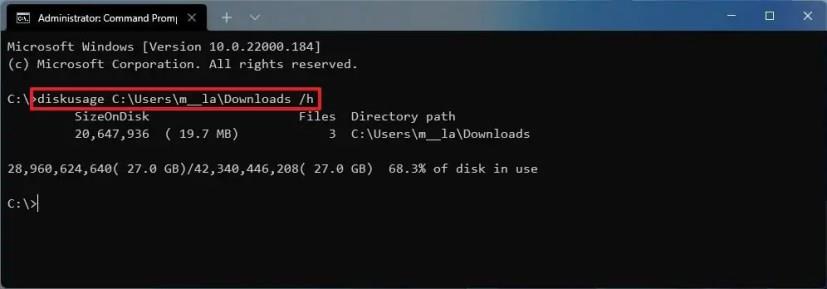
DiskUsage
Das Tool enthält viele Optionen zum Anpassen der Berichtsdetails. Der /minFileSizeBefehl kann beispielsweise dabei helfen, Dateien zu finden, die gleich oder größer der von Ihnen angegebenen Größe sind. Mit /uund /tkönnen Sie die wichtigsten Dateien für einen bestimmten Speicherort und viele andere Optionen anzeigen.
Neu gestaltete Out-of-Box-Erfahrung (OOBE) für Windows 11
Windows 11 führt ein neues Out-of-Box-Erlebnis (OOBE) ein . Dies ist die Erfahrung, die Sie normalerweise machen, um die Ersteinrichtung des Betriebssystems mit einem neuen Konto, Datenschutzeinstellungen und benutzerdefinierten Einstellungen abzuschließen, wenn Sie ein neues Gerät einrichten oder nach einer Neuinstallation.
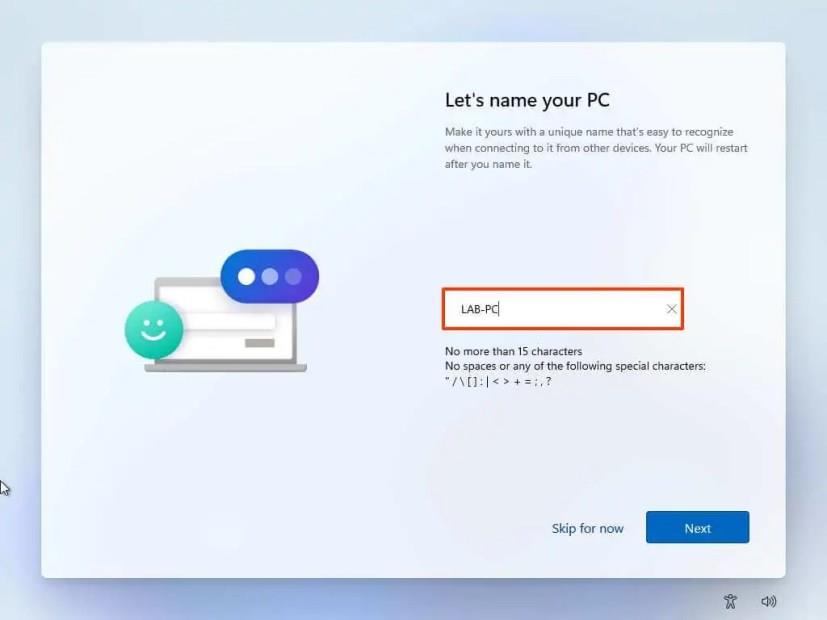
Windows 11-OOBE
Das neue Erlebnis bewegt sich weg von den blauen und dunklen Farben zugunsten von weißen und grauen Farben mit einer intuitiveren und benutzerfreundlicheren Benutzeroberfläche, die der neuen modernen Designsprache von Windows 11 entspricht.
You will also find new animations as you move through each page. Microsoft is even adding an option to set the computer name as you complete the setup in this new version. The option to create an online account is now buried inside the “Sign in options” page, and when setting up Windows 11 Home, users will be required to have an internet connection, and they will be forced to create an account with a Microsoft account. However, there’s a workaround to skip the requirement and continue with an offline account.
Redesigned and new built-in Windows 11 apps
As part of the new Windows 11 overhaul, Microsoft is also updating many of its inbox apps like the Microsoft Store, Paint, Calculator, Clock, Tips, and Snipping Tool, and introducing a few more new apps, such as Power Automate and Chat from Microsoft Teams.
Microsoft Store
Perhaps one of the biggest improvements on Windows 11 is the addition of the new Microsoft Store app. The app has been redesigned with a new interface and animations, making it easier to search and discover content. When you first open the app, you will notice that the search box is centered at the top, and the navigation now appears on the left side.
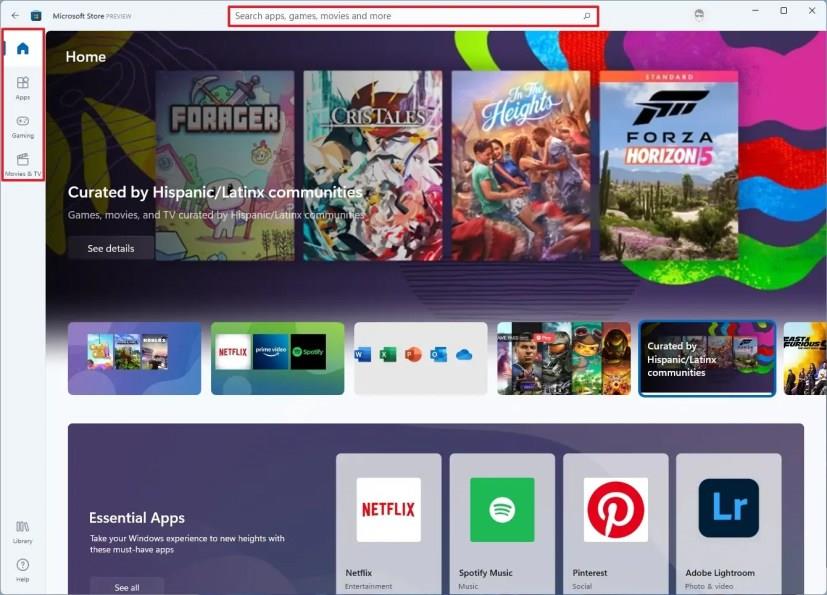
Microsoft Store UI
You still have most of the same categories, including Home, Gaming, Movies & TV, Library, and Help, but the Deal tab is gone.
The product page for apps has also been updated with a new layout that makes it easy to download and install from the left side, while the pages for games, movies and shows will include a vertical orientation.
The “Library” tab that’s where you can go to check for updates. In this section, you will also find a list of all the apps and other content you own across devices.
Finally, the Microsoft Store will now allow developers to make available any type of apps, including traditional Win32, .NET, and web apps. Also, developers now have the option to bring their own monetization platform to keep all the revenue, but the option to use the Microsoft commerce service will still be available.
Get Started
In this new version, Get Started is a new app to help beginners get set up quickly. The app is basic, and it shows things like how to get started with File Explorer, downloading apps, navigating the interface, and going through some basic features.
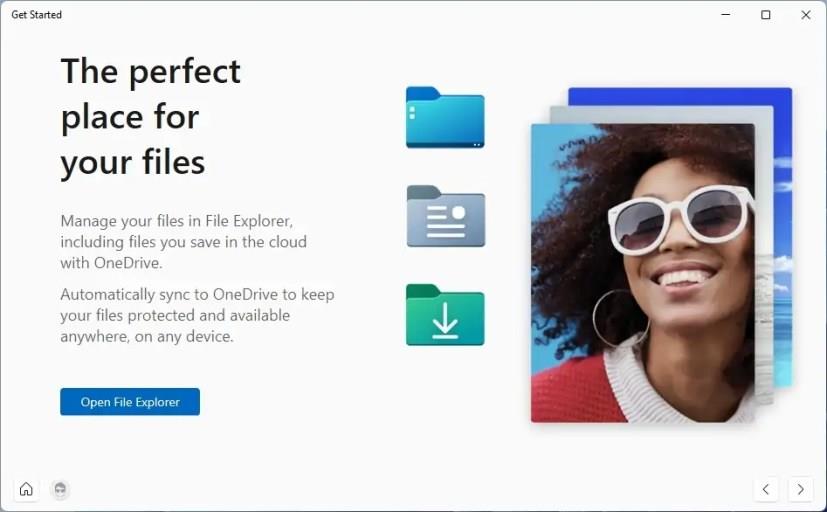
Windows 11 Get Started app
Tips
The Tips app has also been updated, and it’s an app similar to Get Started, but it includes tips to learn more on how to use Windows 11. The app has been available in previous versions but now offers an interface that matches the new design language and features more than one hundred new tips.

Windows 11 Tips app
Calculator
The Calculator app is also receiving an update. The new version has been rewritten in C# and introduces a fresh look that follows Microsoft’s new design language with rounded corners and new materials.
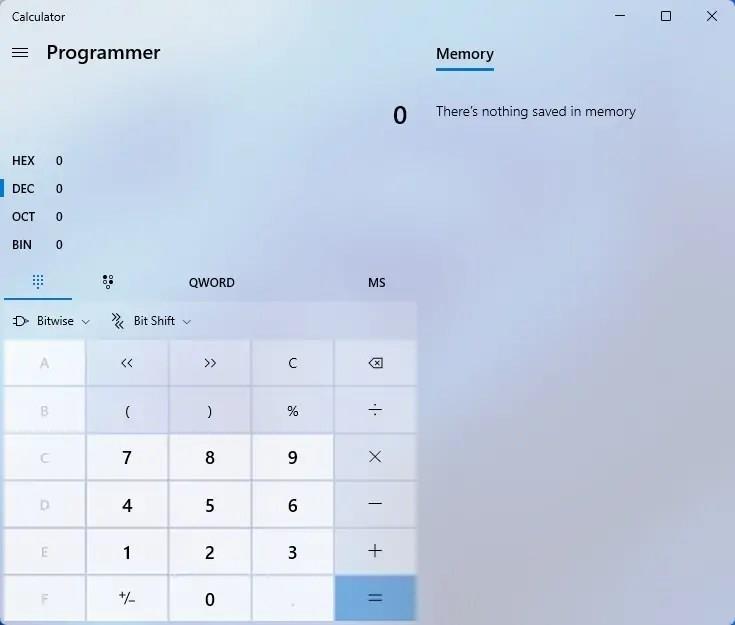
Windows 11 Calculator app
The company has focused on making the app simple for the standard calculator and the powerful scientific calculator in this version.
Also, Programmer Mode offers rich functionality that is essential for programming and engineering. Plot one or more equations in graphing mode and then analyze the graph to help identify key graph features, like the “x-” and “y-” intercepts. And you can now convert in more than 100 different units and currencies.
Clock
On Windows 11, the “Alarms & Clock” app becomes just “Clock,” and along with the new name, the app gets a new interface with rounded corners and semi-transparent materials. Also, this new version comes with Focus Sessions, which is meant to be a new way for users to focus on tasks and work.
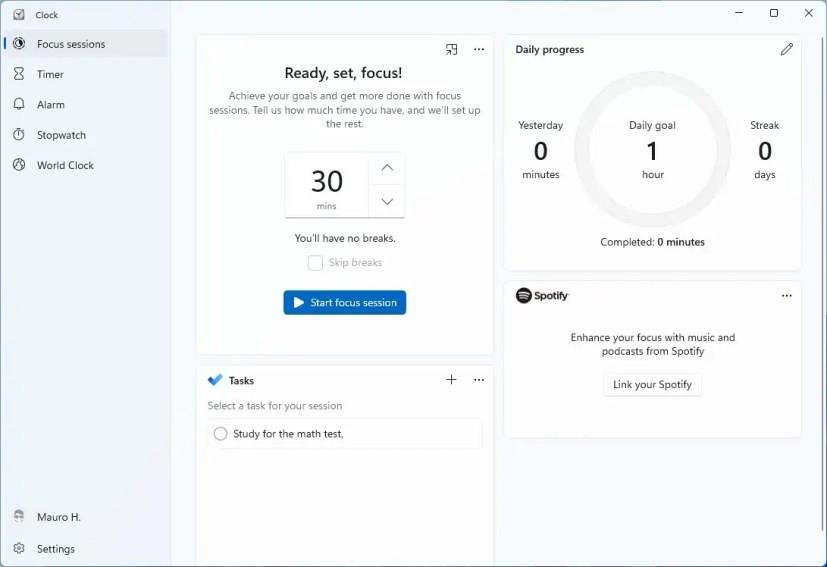
Clock with Focus sessions
Focus Sessions integrates with Spotify, allowing you to create sessions while playing your favorite music playlist to focus and get work done.
So funktioniert es: Sie öffnen die Alarms & Clock-App und wählen im linken Bereich die Focus Sessions aus. Dann würden Sie eine „Microsoft To-Do“-Aufgabe auswählen, eine Spotify-Wiedergabeliste auswählen, den Timer einstellen und auf die Schaltfläche „Fokussitzung starten“ klicken.
Je nach ausgewähltem Zeitraum erhalten Sie außerdem eine Reihe automatischer Pausen, und alle Ihre Fokussitzungen werden im Abschnitt „Täglicher Fortschritt“ auf der rechten Seite nachverfolgt.
Fotos
Die neue Fotos -App verfügt über eine moderne Benutzeroberfläche, die der gleichen Designsprache folgt, die das Unternehmen mit dem Betriebssystem unter Verwendung der WinUI vorantreibt.
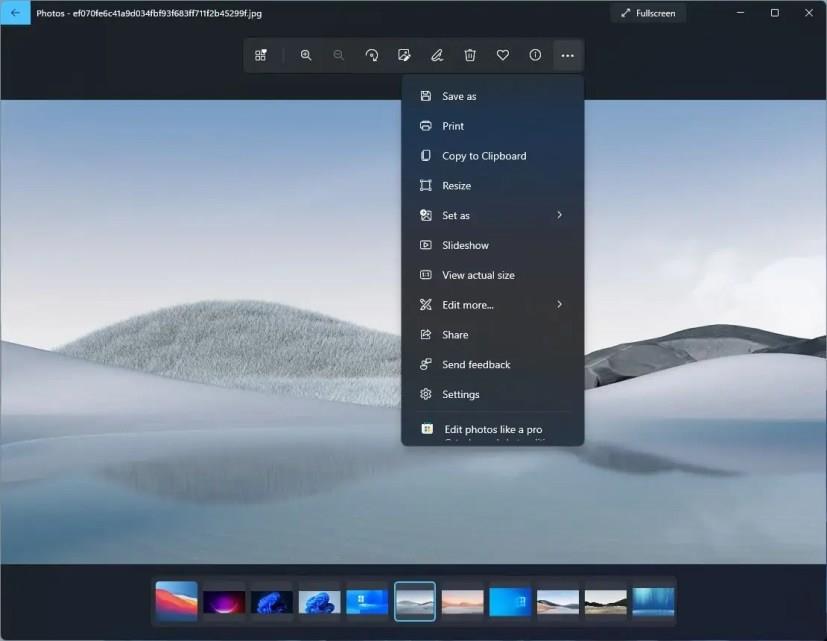
Windows 11 Fotos-App
Die App behält das gleiche klassische Erscheinungsbild bei, enthält jedoch Änderungen, die es den Benutzern erleichtern, ihre Bilder zu organisieren und zu bearbeiten.
„Fotos“ hat immer noch die gleichen fünf Kategorien: Sammlung, Alben, Personen, Ordner und Video-Editor. Wenn Sie nun ein Bild auswählen, wird die gesamte Leinwand der Anwendung geöffnet, und schwebende Elemente geben Ihnen Zugriff auf die Befehle. Und in der unteren Ablage werden zusätzliche Bilder angezeigt, die Sie auswählen können, um eine Gruppe von Bildern anzuzeigen und zu bearbeiten.
Die Befehlsleiste enthält jetzt ein „Markup“-Tool, mit dem Sie das Bild mit Anmerkungen versehen können.
Snipping-Tool
Anstatt die Legacy-Anwendung zu entfernen, kombiniert Microsoft die moderne Snip & Sketch-App mit dem Legacy -Snipping-Tool , um eine neue Einzelanwendung zum Erstellen von Screenshots unter Windows 11 zu erstellen .
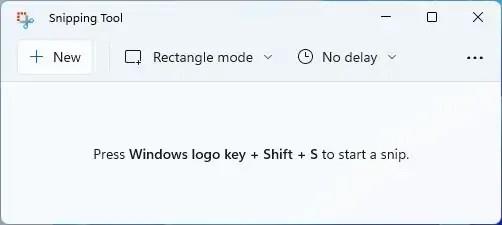
Windows 11 Snipping Tool-App
Das neue Snipping Tool behält das gleiche vertraute Aussehen wie die Legacy-Version, aber die Benutzeroberfläche wurde modernisiert, um der visuellen Designsprache von Windows zu folgen.
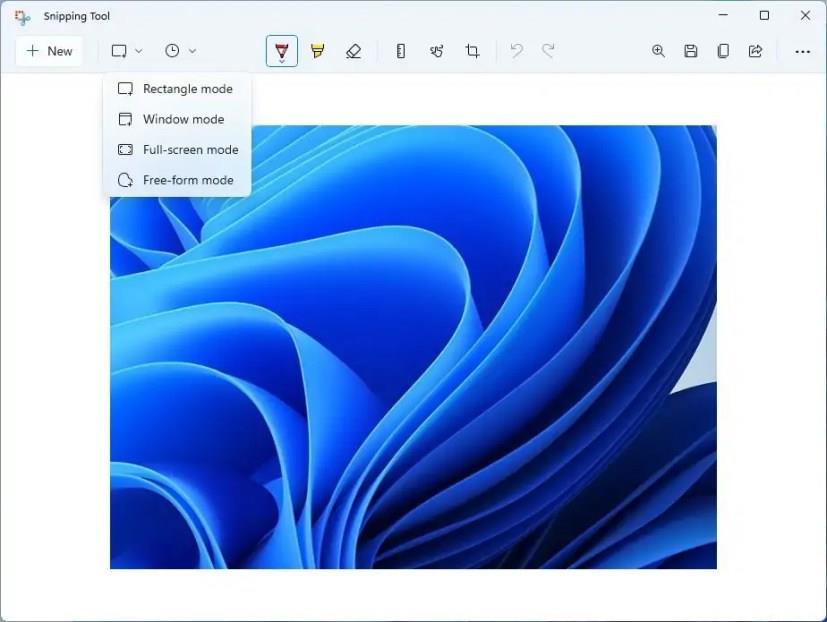
Snipping Tool-Editor
Außerdem bietet die App die besten Funktionen, die in der Snip & Sketch-App verfügbar sind. Wenn Sie beispielsweise die neue App öffnen, erhalten Sie das gleiche vertraute Design, jedoch mit visuellen Elementen von Windows 11, und wenn Sie einen Screenshot erstellen, erhalten Sie die Snip & Sketch-Tools zum Bearbeiten und Kommentieren des Screenshots.
Mail & Kalender
Windows 11 enthält neue Mail- und Kalenderanwendungen . Die neuen Apps integrieren nur abgerundete Ecken und andere visuelle Verbesserungen, bleiben aber praktisch gleich wie die vorherigen Versionen.
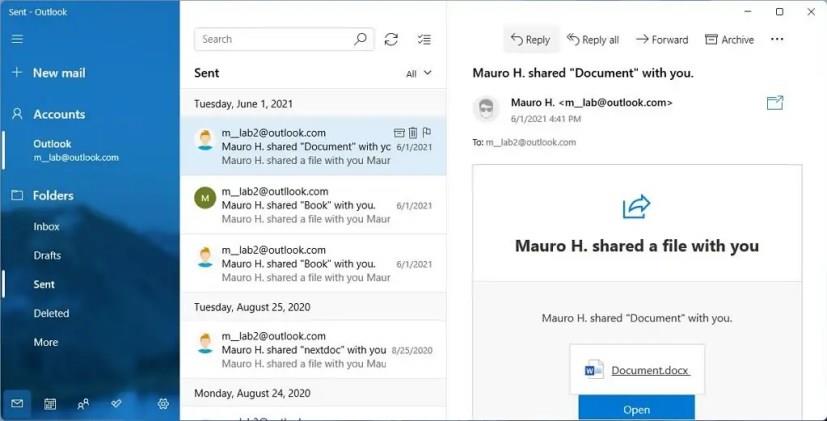
Mail-App für Windows 11
Chatten Sie von Microsoft Teams aus
Microsoft integriert auch Teams in Windows 11, aber dies ist nicht die Vollversion. Stattdessen ist die Funktion als Chat von Microsoft Teams bekannt .
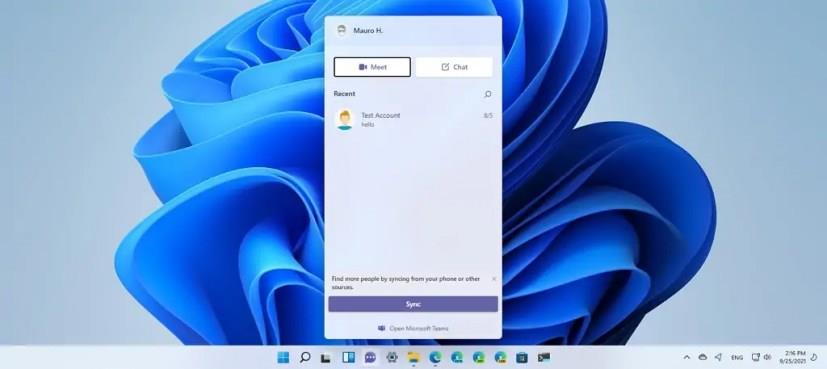
Chatten Sie für Microsoft Teams
Mit dieser Funktion können Sie Einzel- oder Gruppen-Audio- und Videoanrufe tätigen. Sie können Meetings erstellen und daran teilnehmen. Sie können das Mikrofon und die Kamera ein- oder ausschalten. Sie können die bevorzugten Lautsprecher, das Mikrofon und die Kamera auswählen. Sie können Ihren Bildschirm freigeben. Sie können Besprechungseinstellungen verwalten, die Teilnehmerliste anzeigen, Besprechungsteilnehmer aus der Lobby zulassen, chatten und die Videos von Personen in einer Galerieansicht anzeigen.
Die Funktion ist bequem über die Taskleiste verfügbar, und Sie können sich unabhängig von der Plattform, einschließlich Windows, iOS oder Android, mit einer verbinden.
Macht automatisiert
Power Automate is a new app that allows you to automate web and desktop applications by mimicking the user interface actions like clicks and keyboard input to automate repetitive tasks.
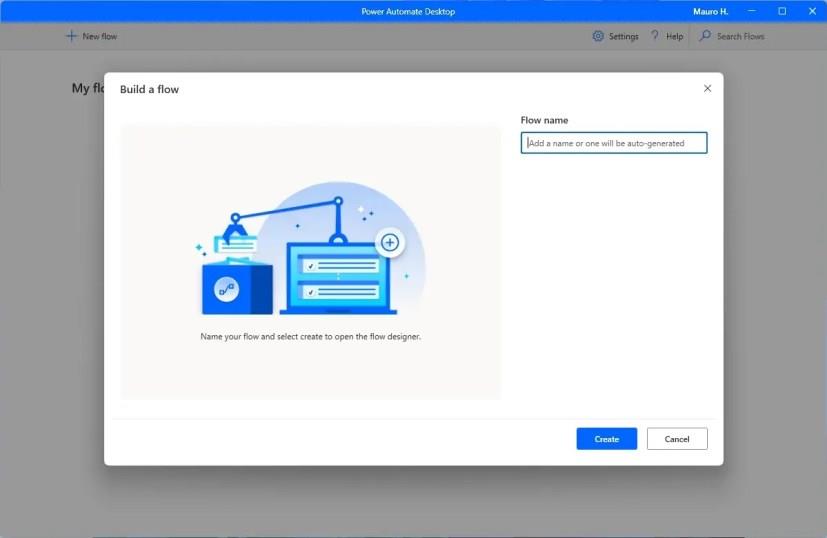
Windows 11 Power Automate app
Conclusion
Overall, Windows 11 is a great new operating system that introduces a much-needed interface lift and delivers many new features and improvements. The latest version seems very stable, and since it’s based on Windows 10, most drivers and applications should just work in this new version.
Es gibt jedoch einige Einschränkungen bei dieser Version. Beispielsweise werden Sie in der gesamten Erfahrung immer noch viele Inkonsistenzen in der Benutzeroberfläche finden, wie Menüs und Elemente, die nicht auf die neue Designsprache aktualisiert wurden. Außerdem sind noch viele ältere Tools vorhanden, wie die Systemsteuerung und andere, die nicht aktualisiert wurden, wie Task-Manager und Geräte-Manager.
Beim Navigieren und Ausführen von Aufgaben fühlt sich Windows schneller und stabiler an, aber es gibt immer noch viele Designfehler oder unvollständige Dinge. Darüber hinaus werden während der anfänglichen Rollout-Phase viele Funktionen wie die Unterstützung für Android-Apps nicht Teil von Windows 11 sein.
Eines der wesentlichen Probleme mit dieser Version ist die Erhöhung der Systemanforderungen, die deutlich neuere Prozessoren und Sicherheitsfunktionen wie TPM 2.0 und Secure Boot erfordern , wodurch viele gut funktionierende Computer ohne die Möglichkeit eines Upgrades bleiben.
Unter Berücksichtigung aller guten und schlechten Punkte erhält Windows 11 3,5 von 5 Sternen für die Bewertung .
Das Windows-11-Update KB5007262 bringt neue 2D-Emojis statt des ursprünglich versprochenen 3D-Stils. Hier erfahren Sie, wie Sie sie erhalten.
Sicherheitsforscher offenbaren Zero-Day-Schwachstelle in Windows 11 aufgrund geringer Auszahlung von Microsoft in seinem Bug-Bounty-Programm.
Das Windows 11-Event beginnt am 24. Juni um 11:00 Uhr ET / 8:00 Uhr PT und Sie können es live auf dieser Microsoft-Website verfolgen.
Microsoft plant, am 5. April ein Hybrid-Work-Event zu veranstalten, um neue Funktionen von Windows 11 zu zeigen und das Betriebssystem an gewerbliche Kunden zu verkaufen.
Windows 11 zeigt Systemvoraussetzungen nicht erfüllt an. Gehen Sie zu Einstellungen, um mehr über das Wasserzeichen auf einer unterstützten Hardware zu erfahren, aber Sie können es entfernen.
Microsoft bringt Optimierungen für Fensterspiele und eine neue Windows HDR-Kalibrierungs-App, um das Windows 11-Spielerlebnis zu verbessern.
Sie können jetzt eine physische Kopie von Windows 11 Home oder Pro in Ihrem örtlichen Einzelhandelsgeschäft kaufen. Die Box enthält ein USB-Medium und einen Produktschlüssel.
Windows 11 hat ein Problem, das dazu führt, dass langsamere NVMe-Laufwerke langsamer arbeiten als unter Windows 10, und Microsoft muss das Problem noch bestätigen und beheben.
Sehen Sie sich zunächst das neue Installationserlebnis von Windows 11 an, einschließlich einer brandneuen Benutzeroberfläche für das Out-of-Box-Erlebnis (OOBE).
Windows 11 (21H2) ist für eine breite Bereitstellung vorgesehen, was bedeutet, dass es jetzt für alle kompatiblen Computer verfügbar ist.
Die Taskleiste unter Windows 11 wird Berichten zufolge im nächsten Funktionsupdate nach vielen Benutzerrückmeldungen per Drag & Drop verschoben.
Die App „Einstellungen“ für Windows 11 erhält möglicherweise neue Hero-Steuerelemente und Erinnerungsanforderungen für nicht unterstützte Geräte.
Die Windows 11-Taskleiste kann jetzt dynamische Benachrichtigungen (Wetter, Sport, Finanzen, aktuelle Nachrichten) in den Widgets-Symbolen anzeigen. Details hier.
Windows 11 ist die nächstgrößere Version des Microsoft-Betriebssystems, und hier sind die zu erwartenden Funktionen und Änderungen sowie das Veröffentlichungsdatum.
Neue Touch-Gesten kommen zu Windows 11, einschließlich Gesten zum Navigieren im Startmenü, Schnelleinstellungen, Animationen und Greifer.
Windows 11 Pro erfordert jetzt ein Microsoft-Konto, um ein neues Gerät einzurichten oder eine Neuinstallation durchzuführen, wodurch die Option zum Erstellen eines lokalen Kontos entfernt wird.
Microsoft pusht die erste Beta-Version von Windows 11.
Microsoft plant, Hardwareanforderungen durchzusetzen, um zu verhindern, dass nicht unterstützte Geräte Windows 11 installieren.
Vollständige Liste bekannter Probleme für die ursprüngliche Version von Windows 11. Microsoft verhängt eine temporäre Upgrade-Sperre auf betroffenen Geräten.
Können Sie nicht mit Menschen kommunizieren, die verschiedene Sprachen sprechen, weil Skypes Translator nicht funktioniert? Sehen Sie sich 3 Möglichkeiten an, das Problem auf Mobilgeräten und Windows PCs zu beheben.
Microsoft Teams bietet eine Vielzahl von Produktivitätsfunktionen. Erfahren Sie, wie Sie Ihr Profilbild ändern können und wo häufige Probleme auftreten können.
Detaillierte Anleitung zum Ausblenden/Anzeigen von Chats in Microsoft Teams mit Tipps zur Optimierung des Arbeitsbereichs. Entdecken Sie die Tricks, die 300 Millionen Teams-Nutzer anwenden.
Erfahren Sie, wie Sie Benachrichtigungen in Microsoft Teams effektiv deaktivieren können, um störende Unterbrechungen während der Zusammenarbeit zu vermeiden.
Benutzer können das Profilbild von Microsoft Teams auf dem Desktop und auf Mobilgeräten ganz einfach ändern. Lesen Sie den Beitrag, um zu erfahren, wie das auf Mac, Windows, iOS und Android geht.
Erfahren Sie, wie Sie in Google Docs Rahmen hinzufügen können, indem Sie eine 1x1-Tabelle erstellen oder andere kreative Lösungen nutzen.
Erfahren Sie, wie Sie Snapchat-Filter aus gespeicherten Fotos entfernen können. Schritt-für-Schritt-Anleitung mit Bildern und neuen Tipps zur Bearbeitung von Snapchat-Bildern.
Erfahren Sie, wie Sie den Microsoft Teams-Status auf immer verfügbar setzen können, damit Sie während Meetings hervorragend kommunizieren können.
Erfahren Sie, wie Sie Bumble zurücksetzen, um Ihre Likes, Swipes und Ihre Wahrscheinlichkeit für Matches zu erhöhen.
Erfahren Sie, wie Sie die bedingte Formatierung in Google Tabellen effektiv anwenden können, basierend auf einer anderen Zelle, und optimieren Sie Ihre Tabellen mit diesen wertvollen Techniken.
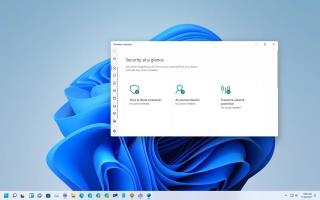



















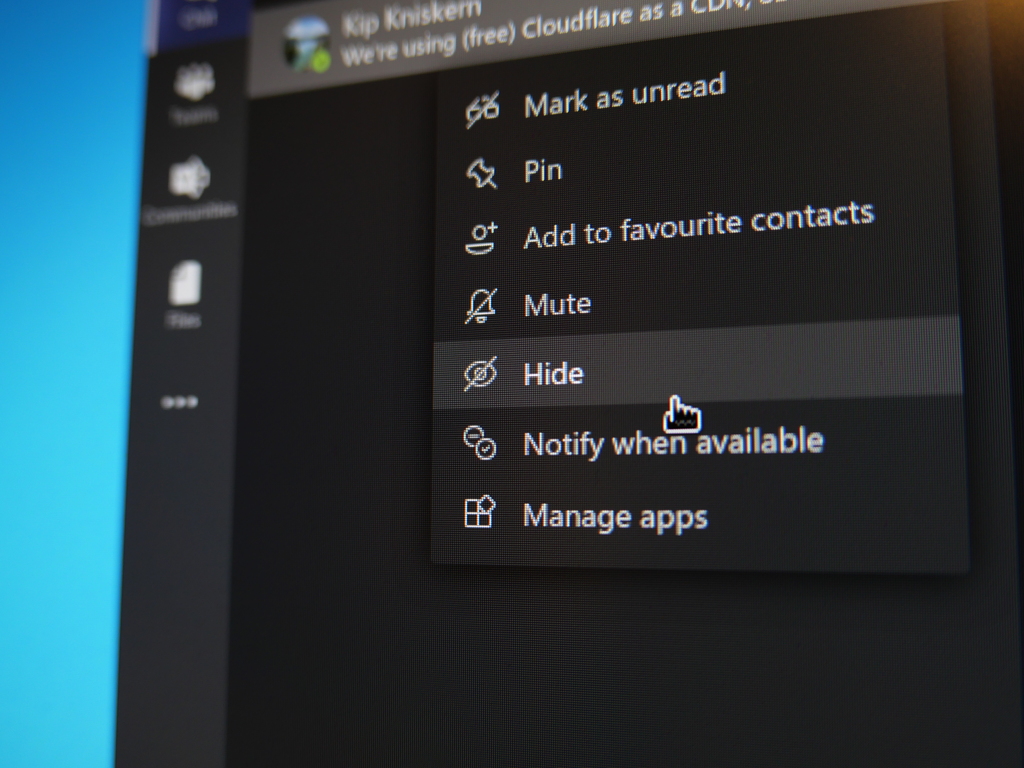
![So deaktivieren Sie Benachrichtigungen in Microsoft Teams [AIO] So deaktivieren Sie Benachrichtigungen in Microsoft Teams [AIO]](https://cloudo3.com/resources8/images31/image-2249-0105182830838.png)



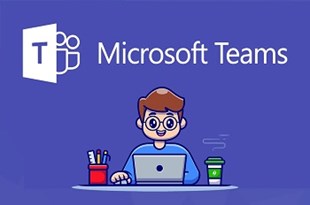

![Bedingte Formatierung basierend auf einer anderen Zelle [Google Tabellen] Bedingte Formatierung basierend auf einer anderen Zelle [Google Tabellen]](https://cloudo3.com/resources3/images10/image-235-1009001311315.jpg)